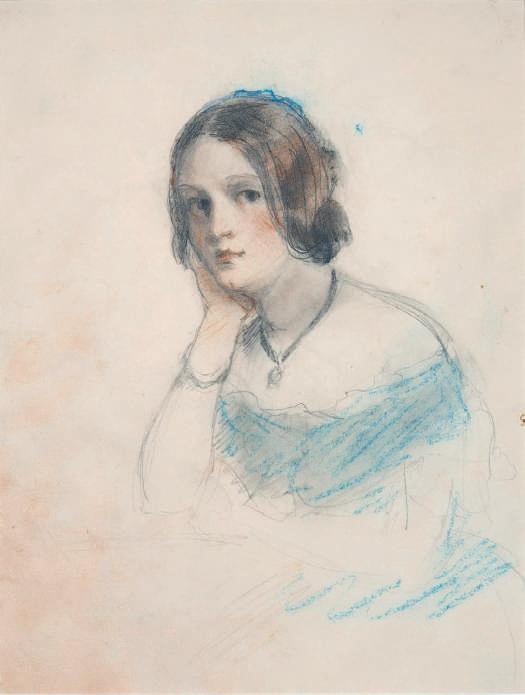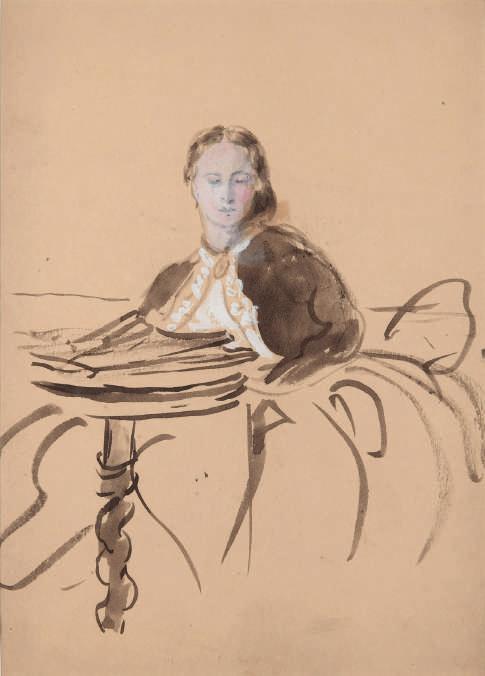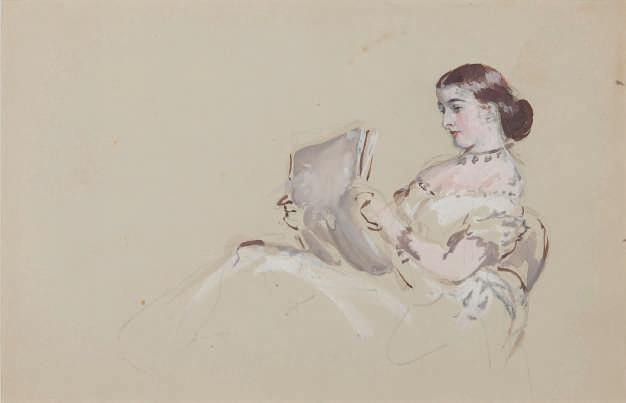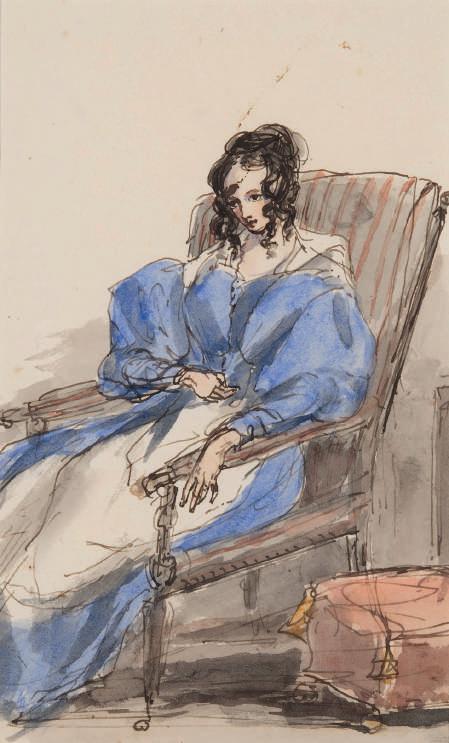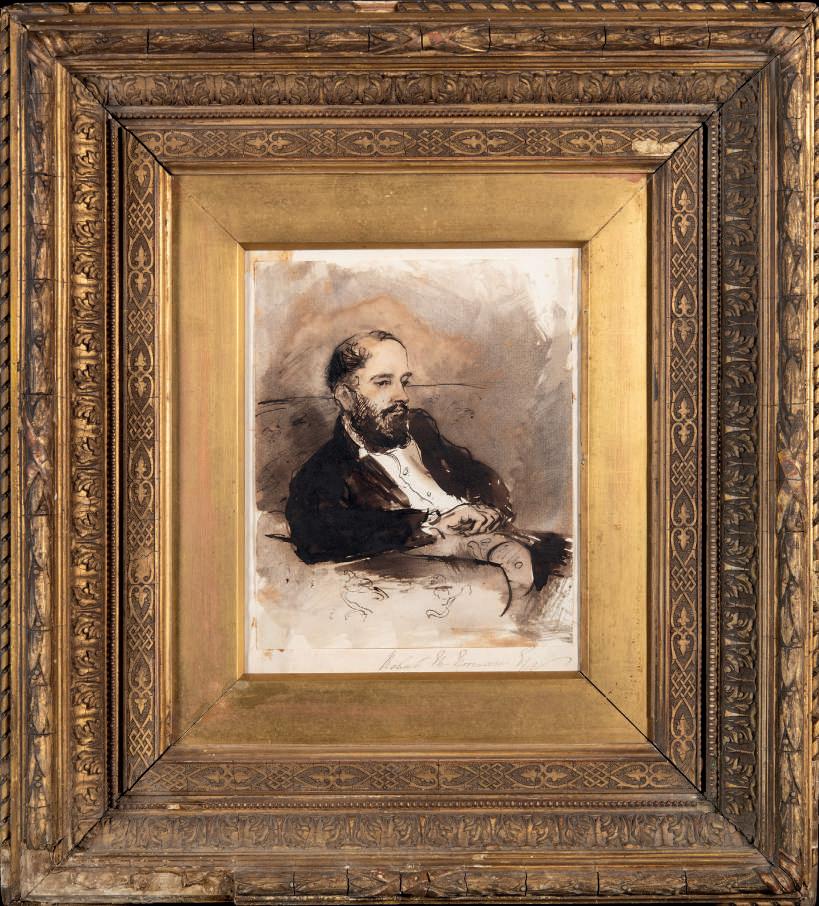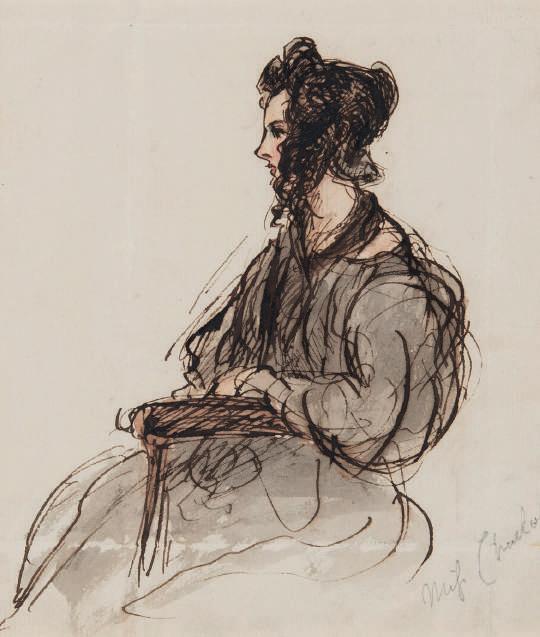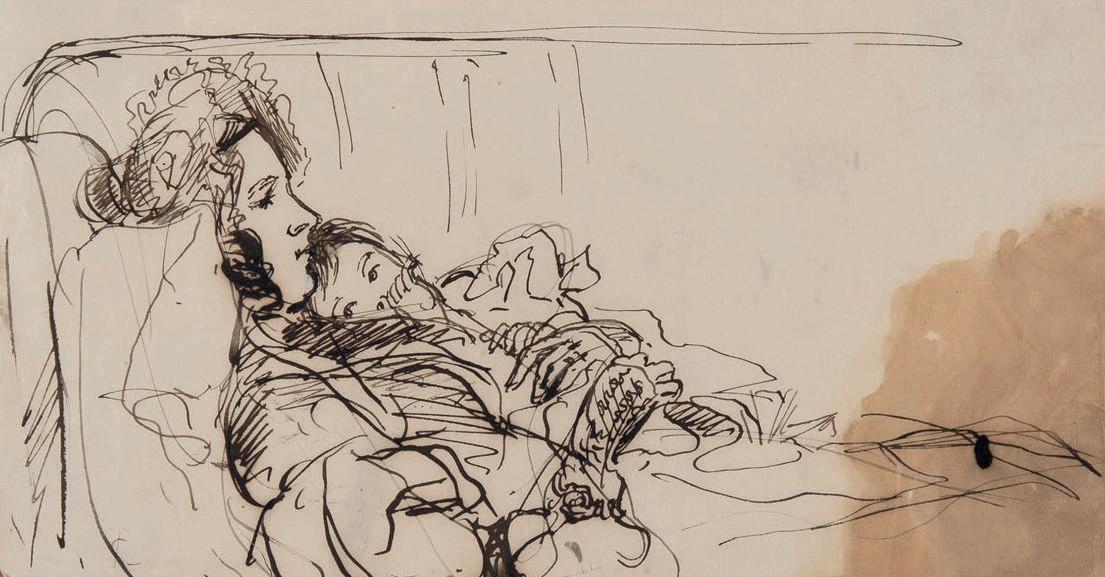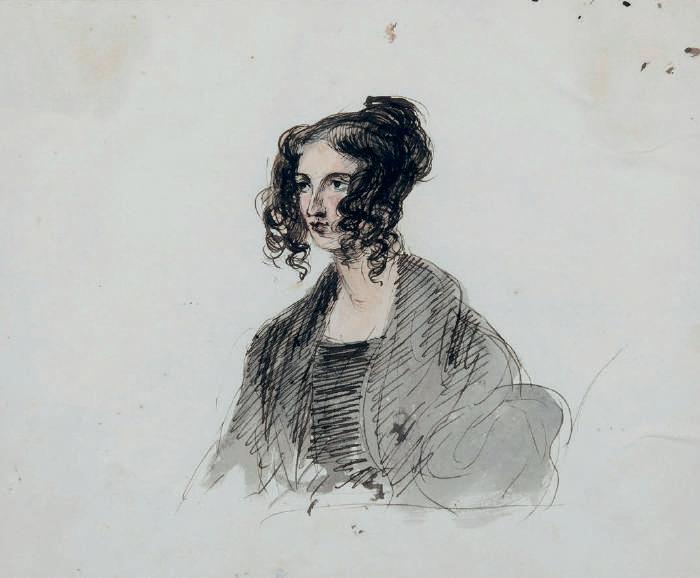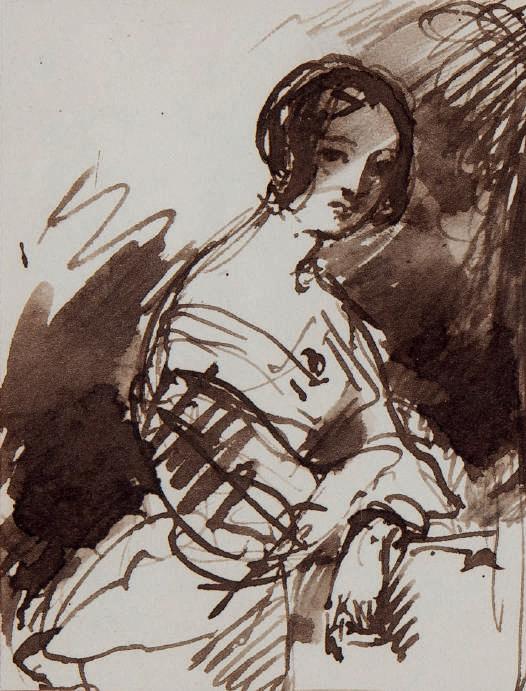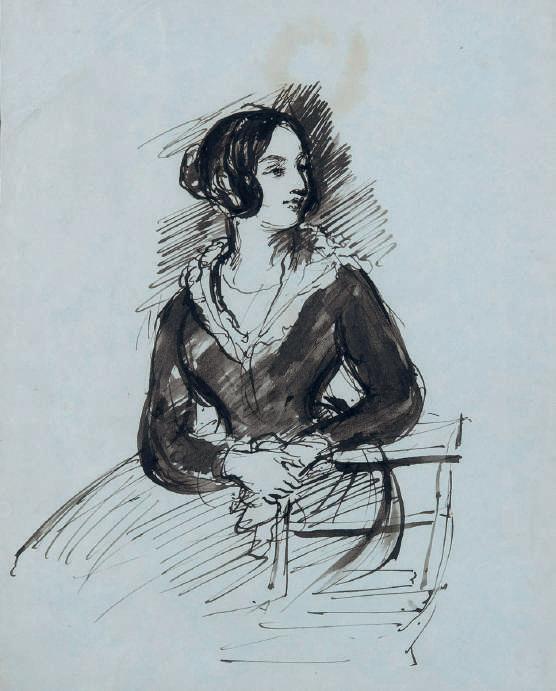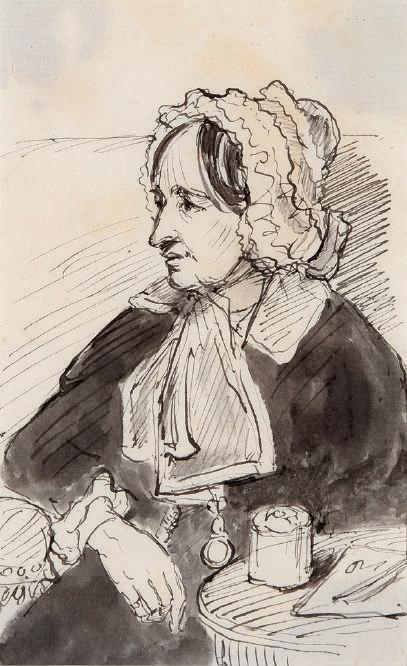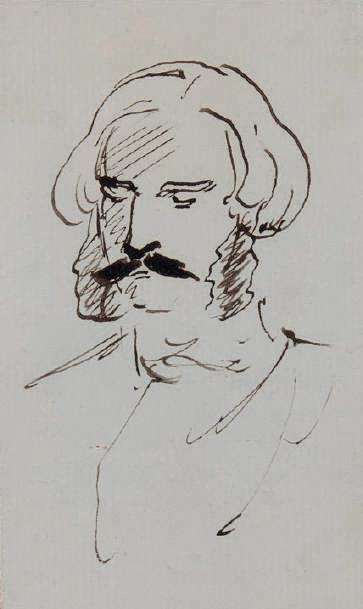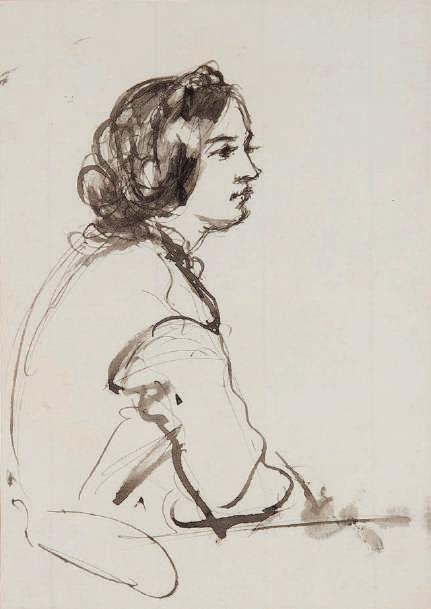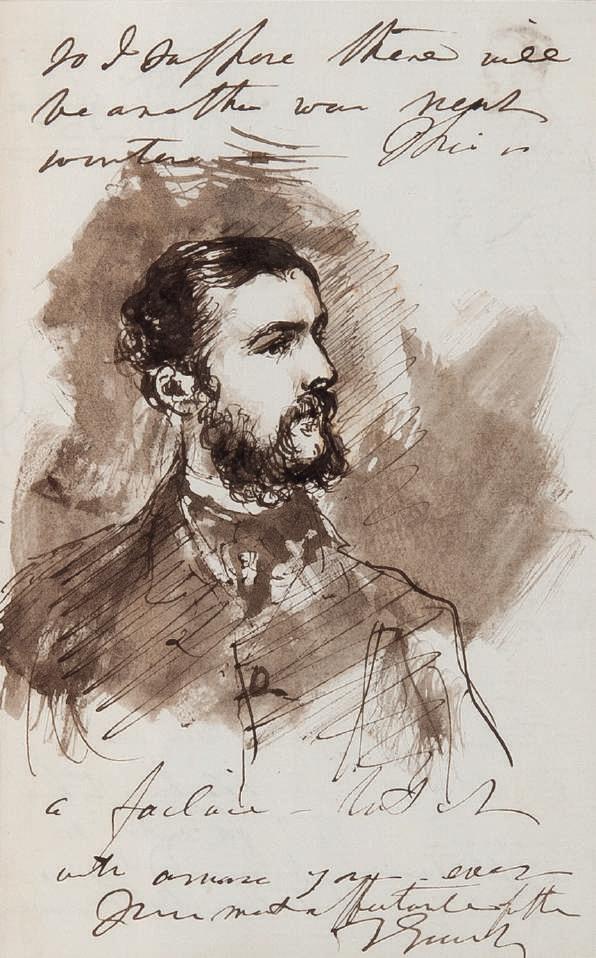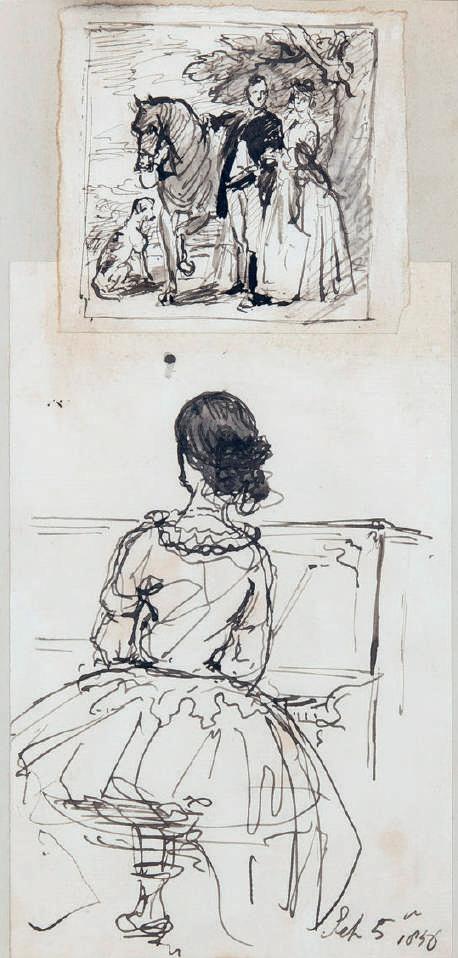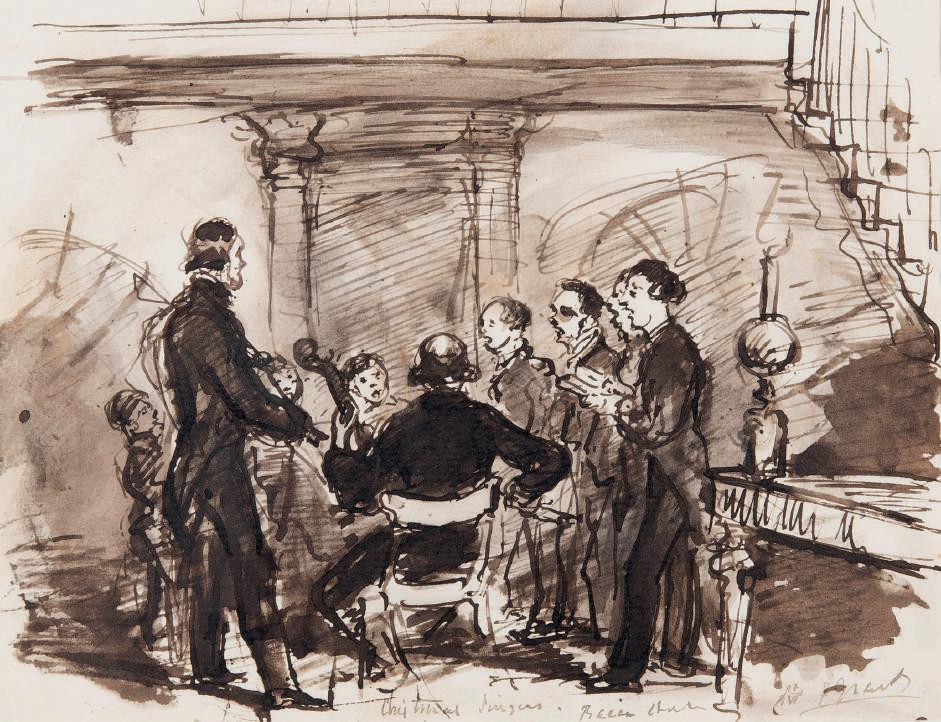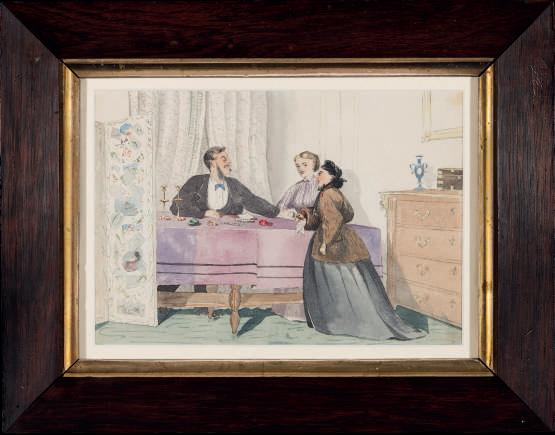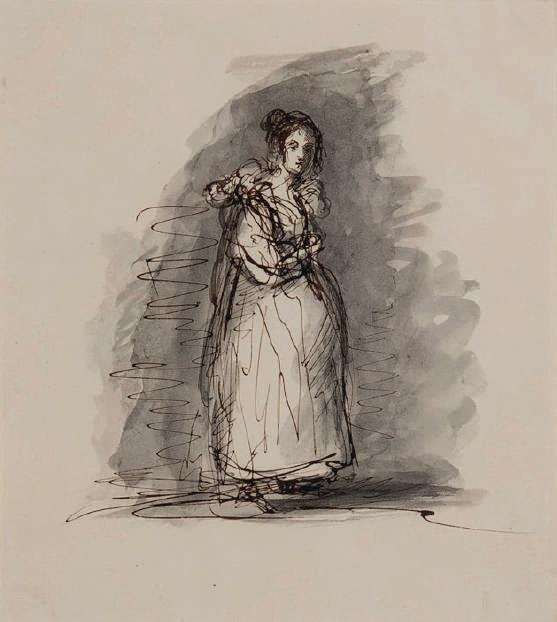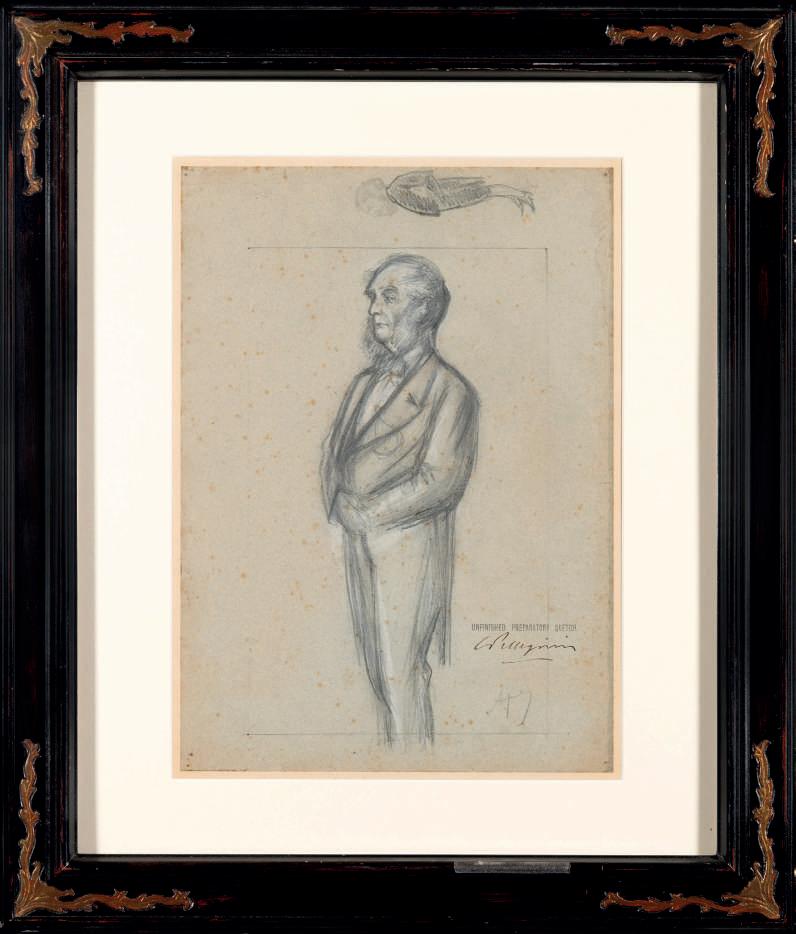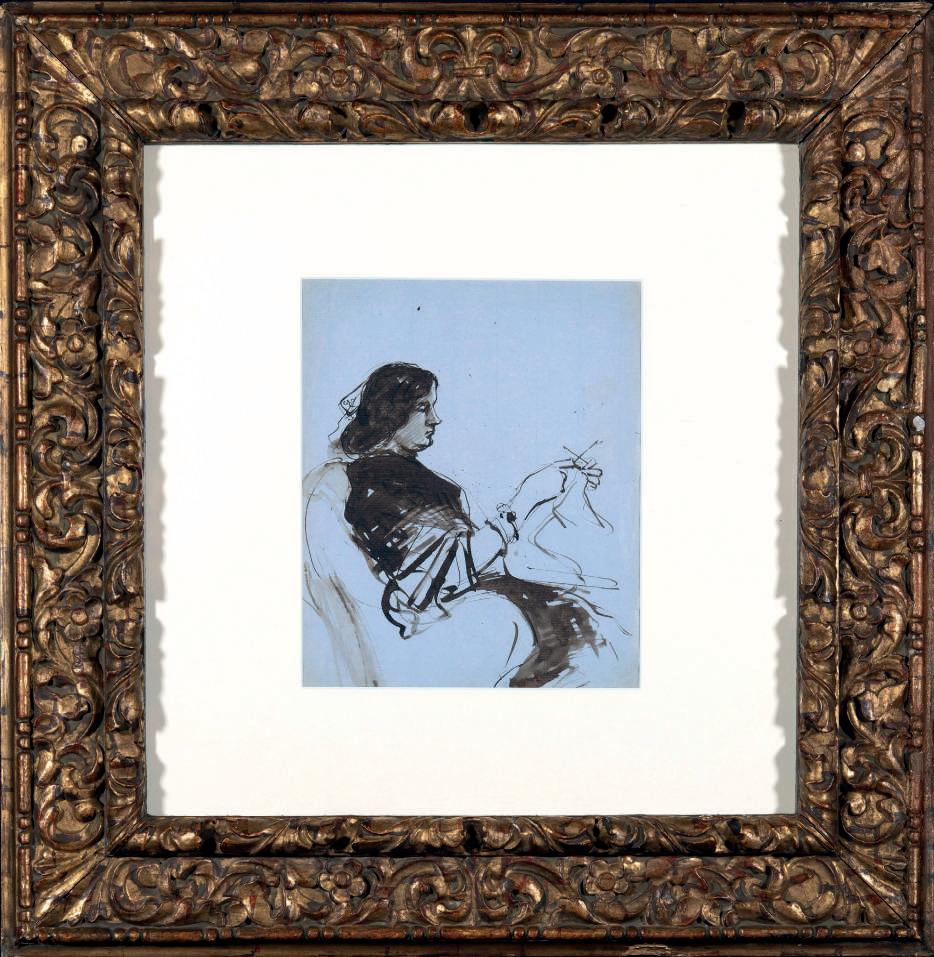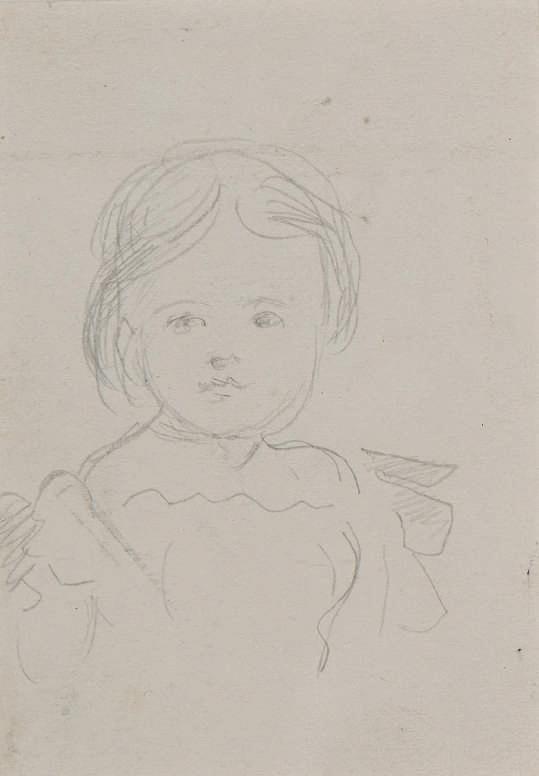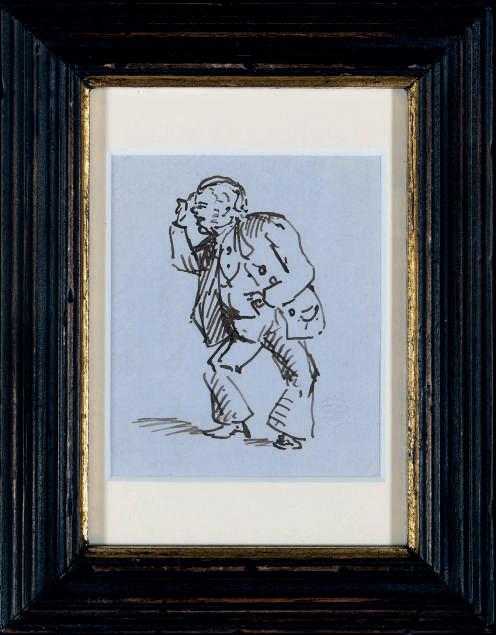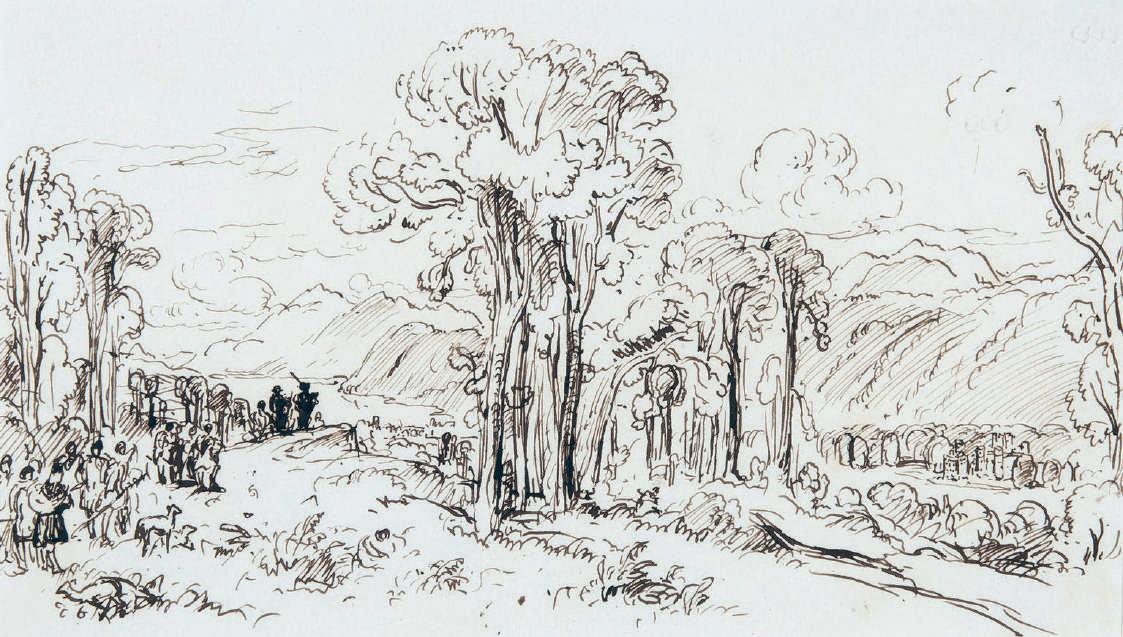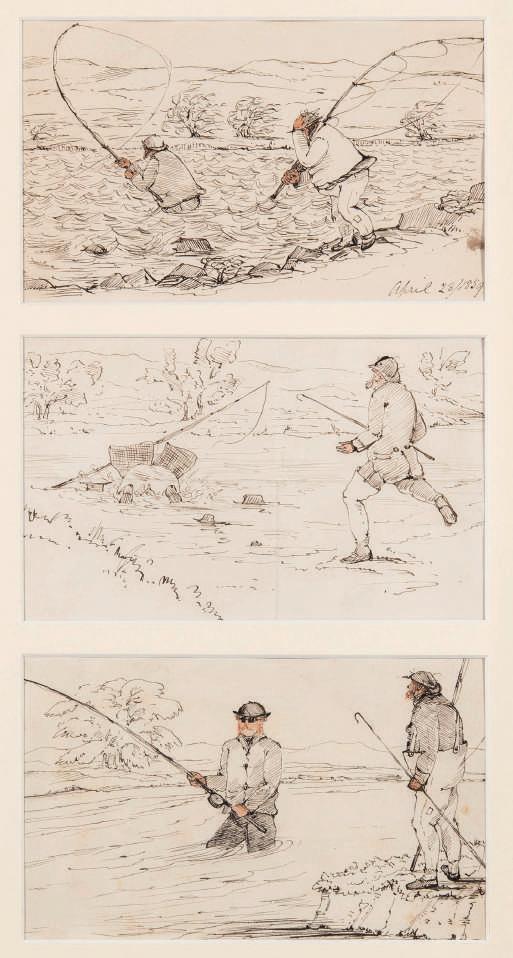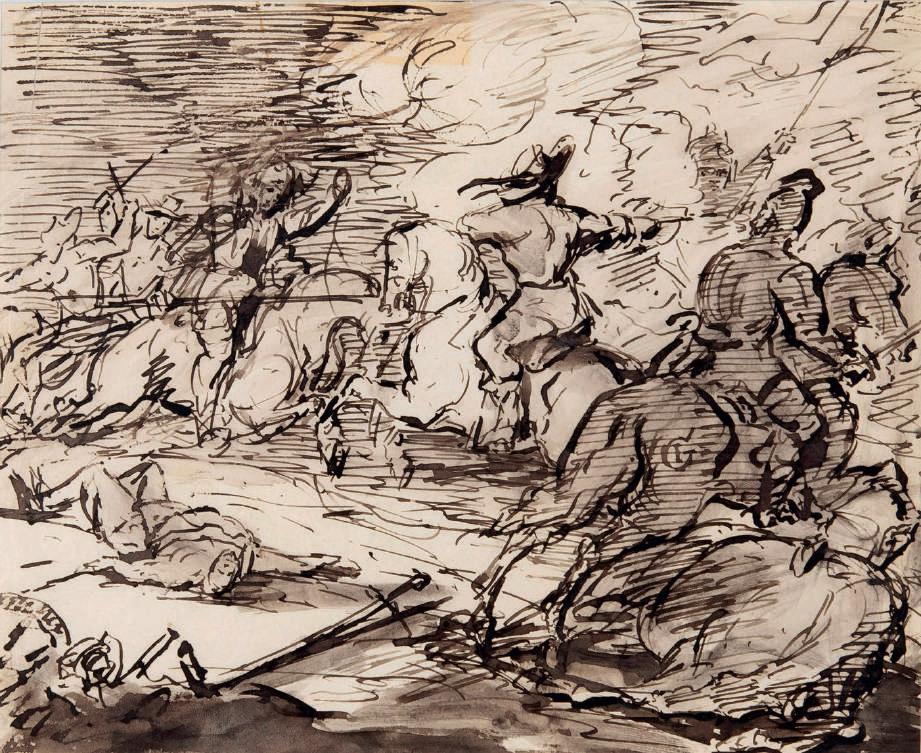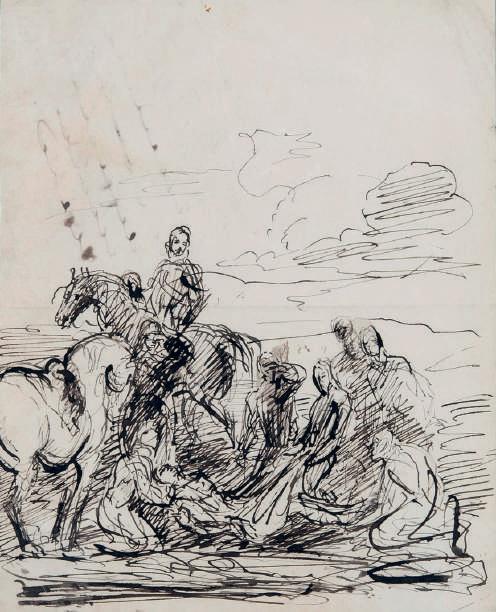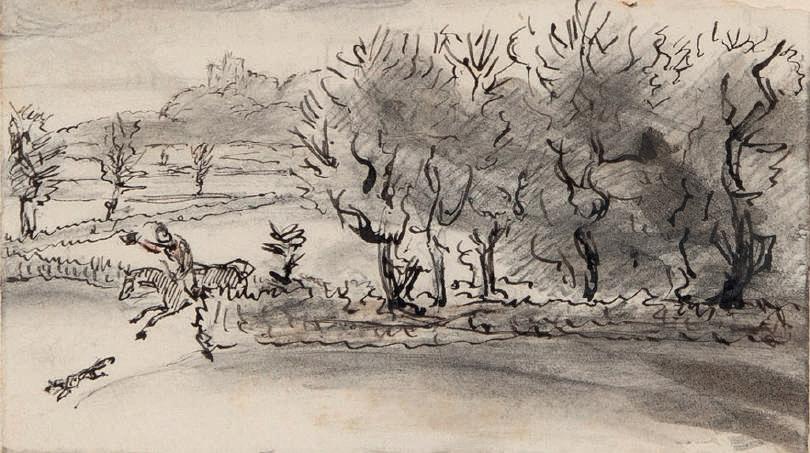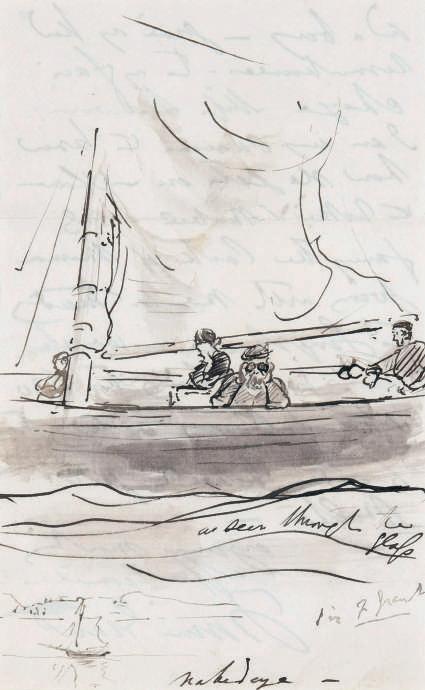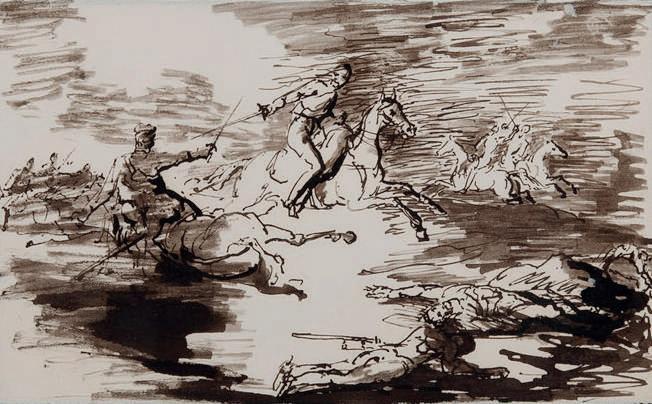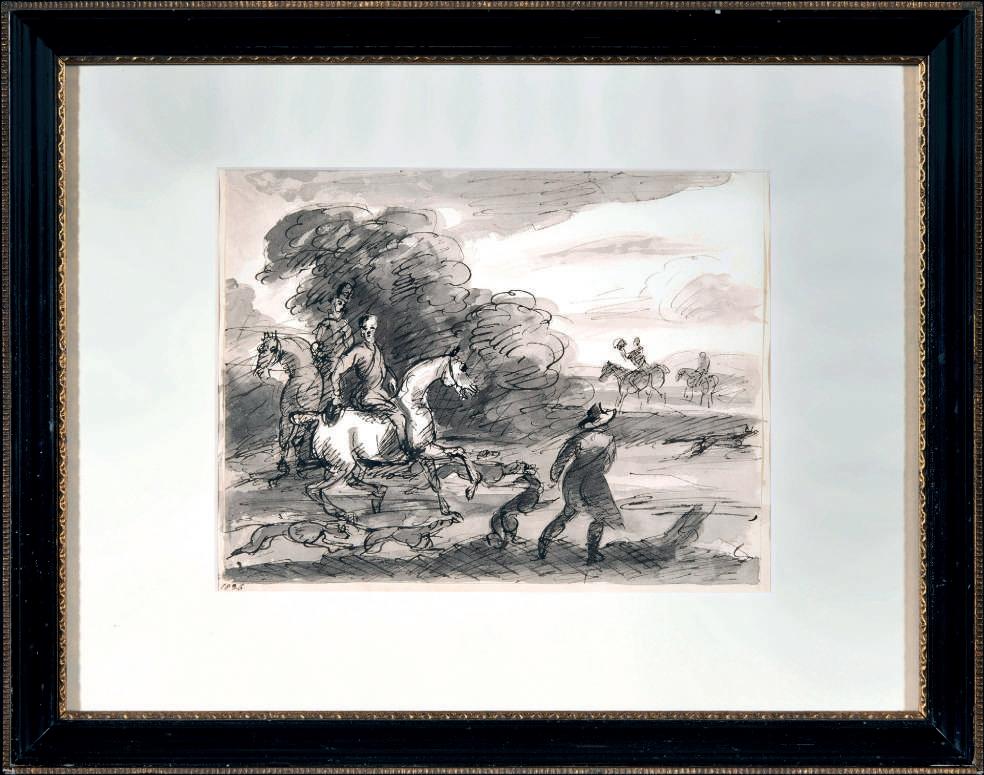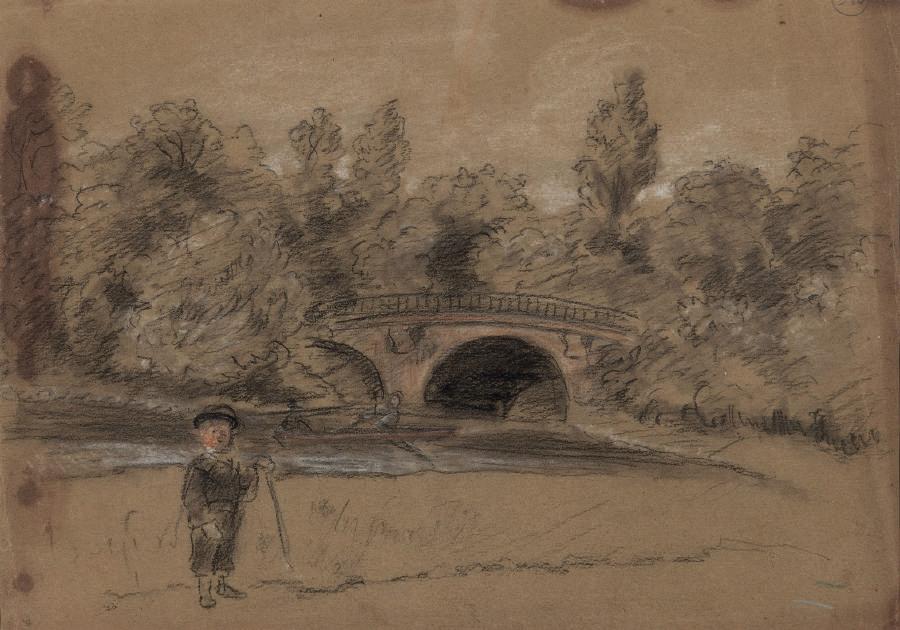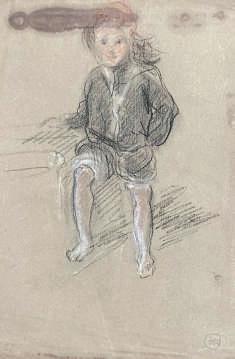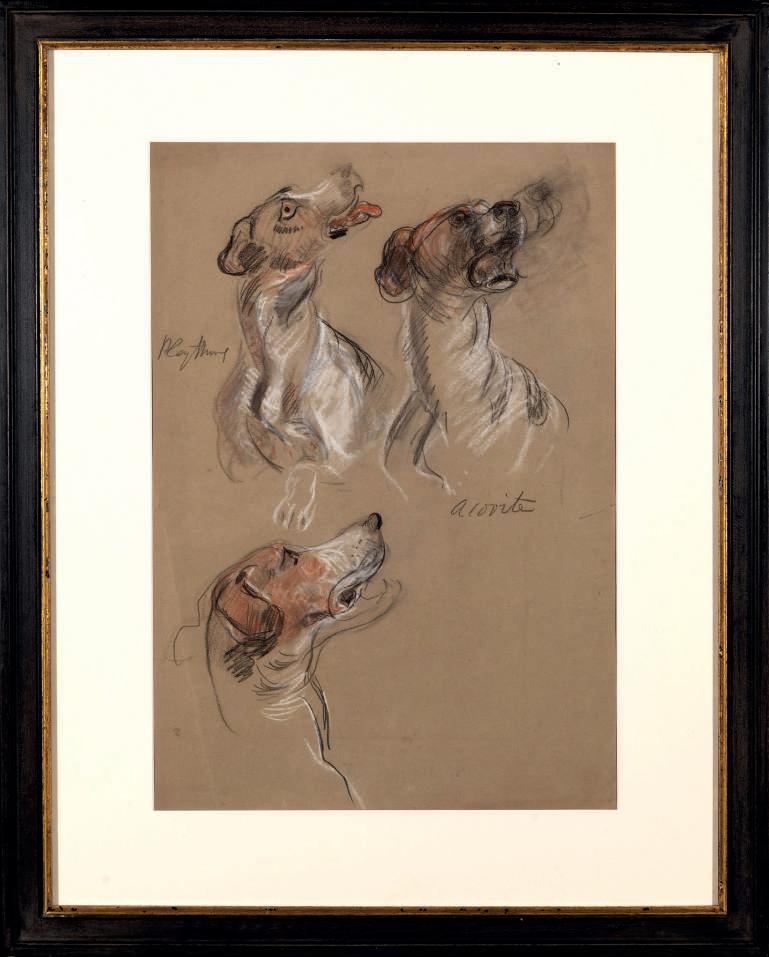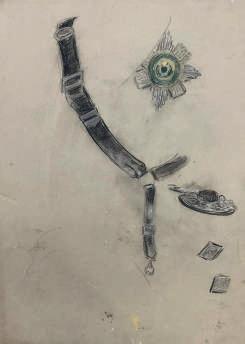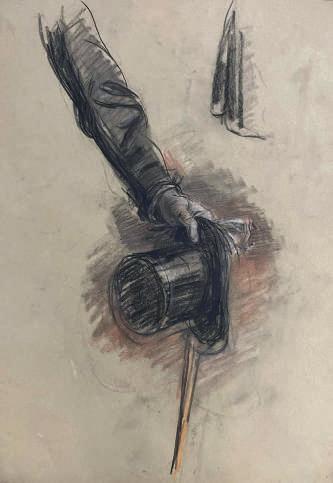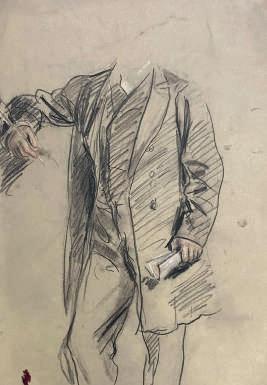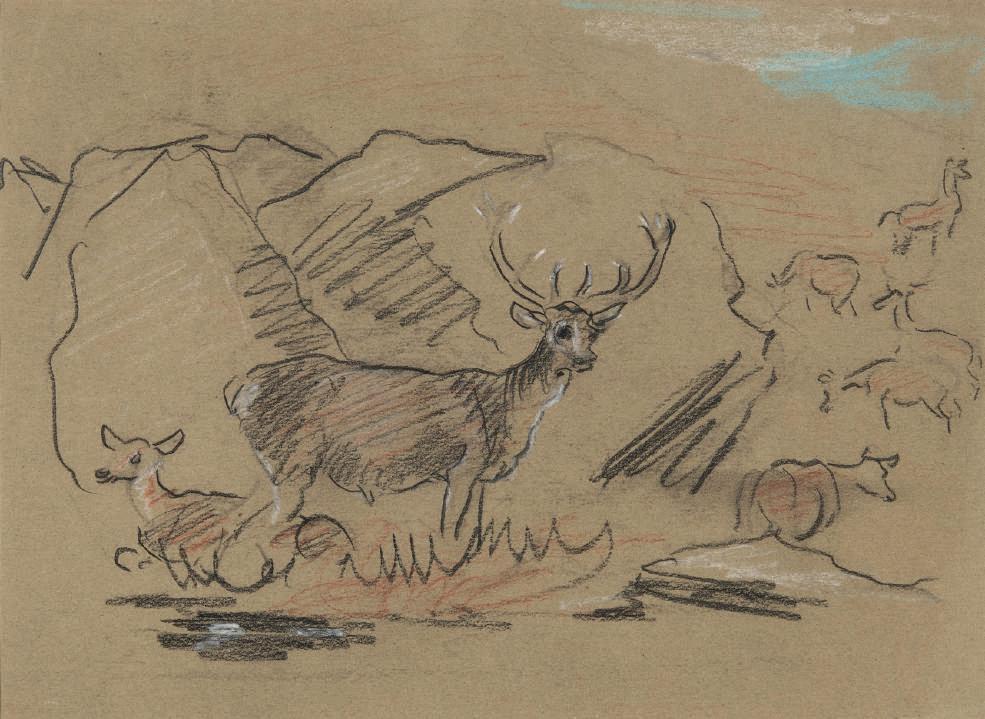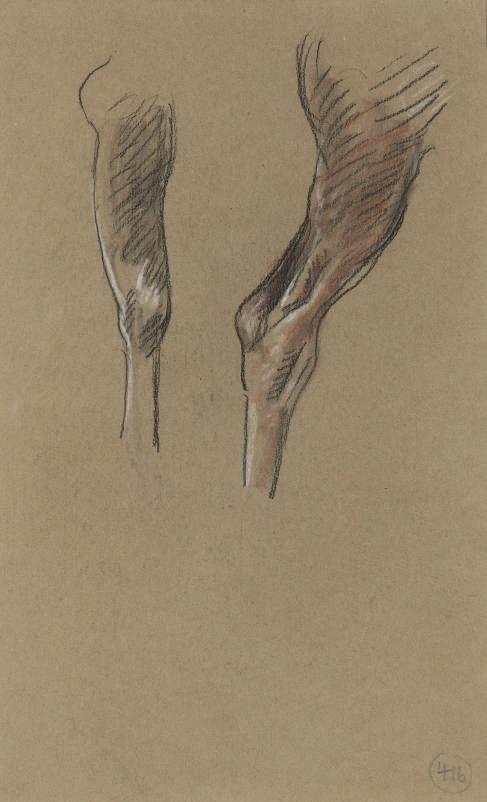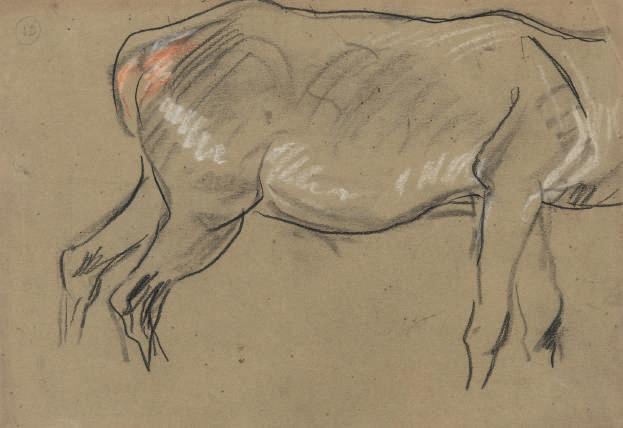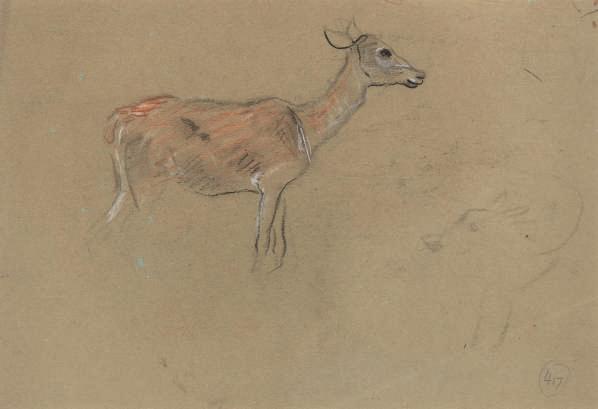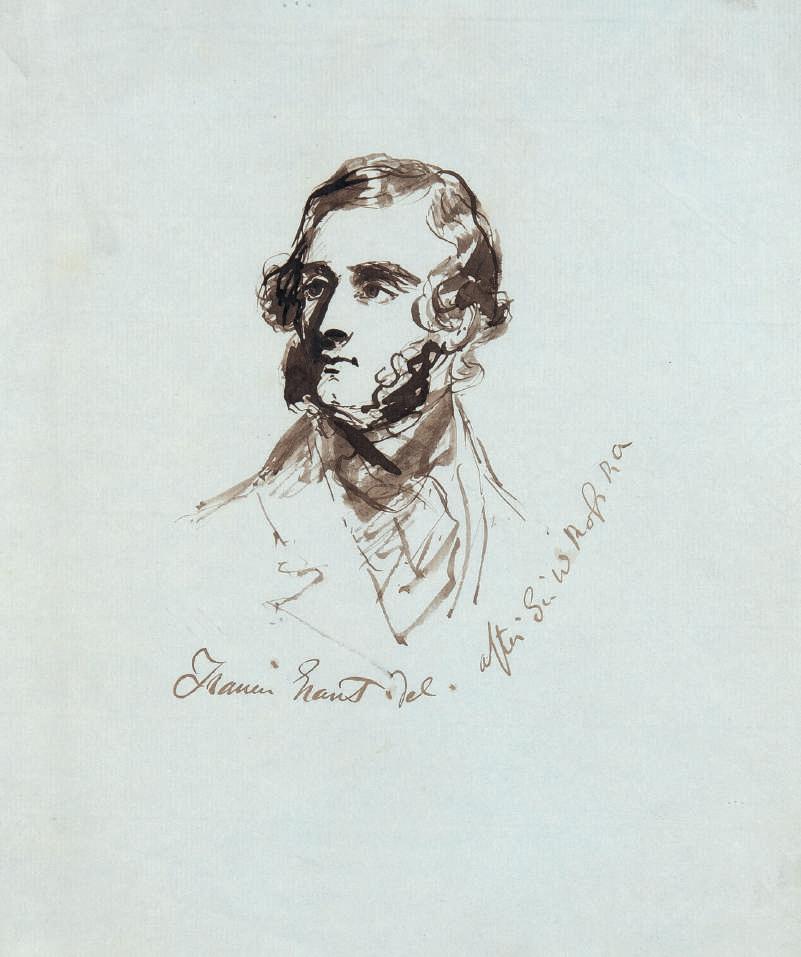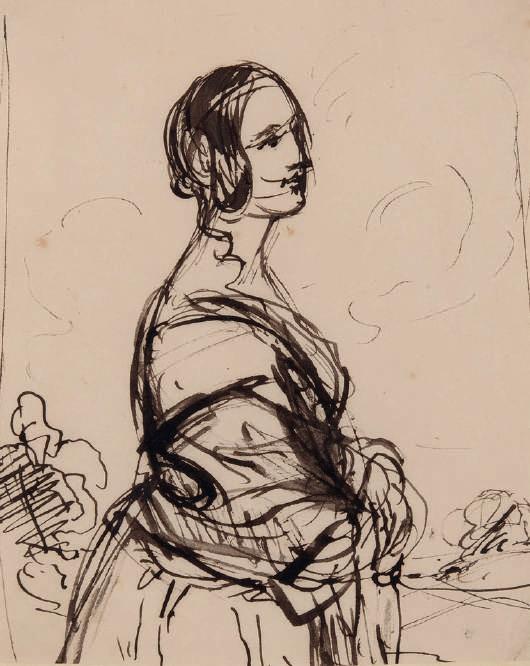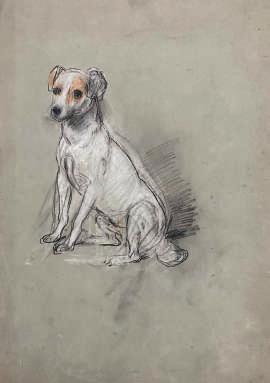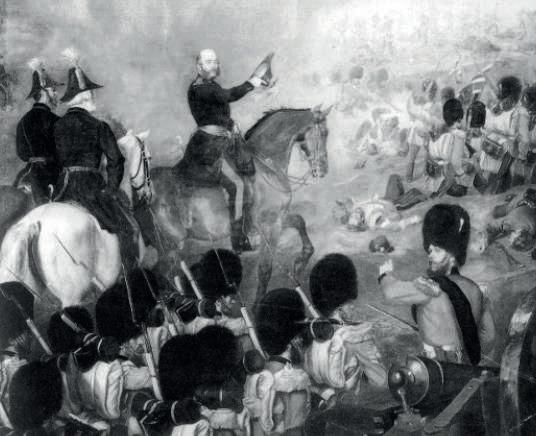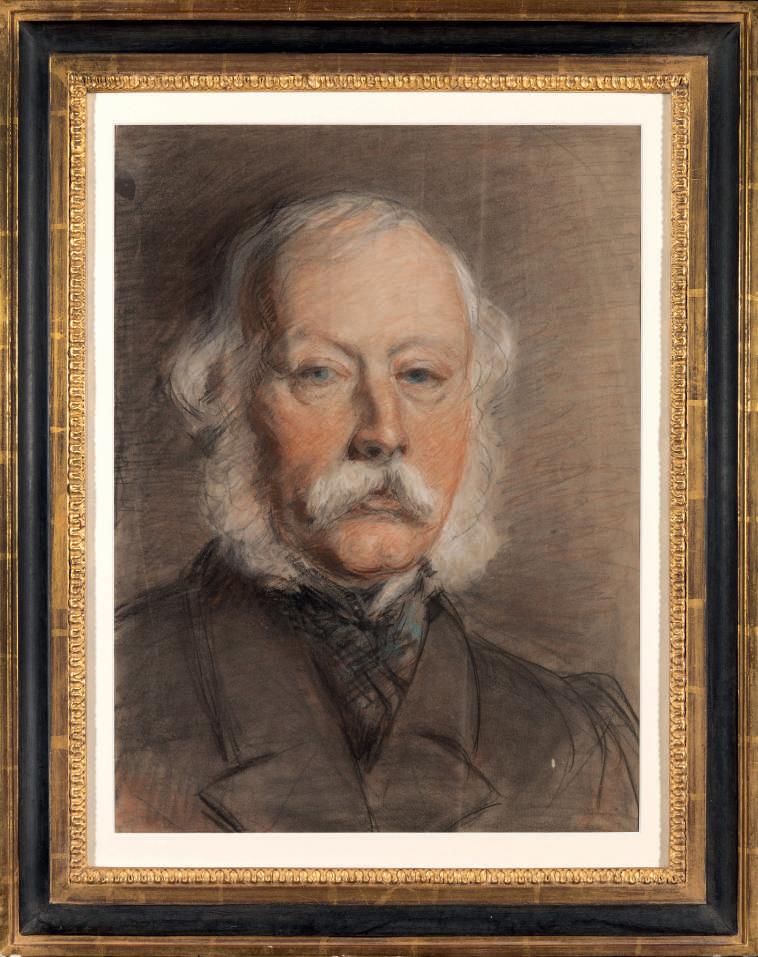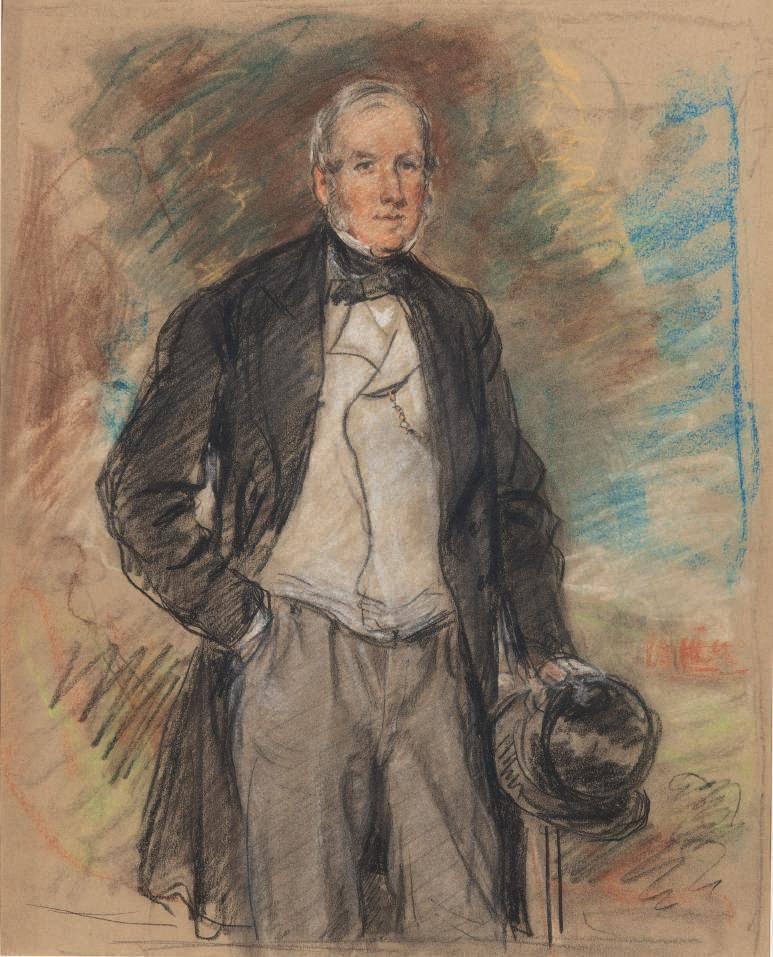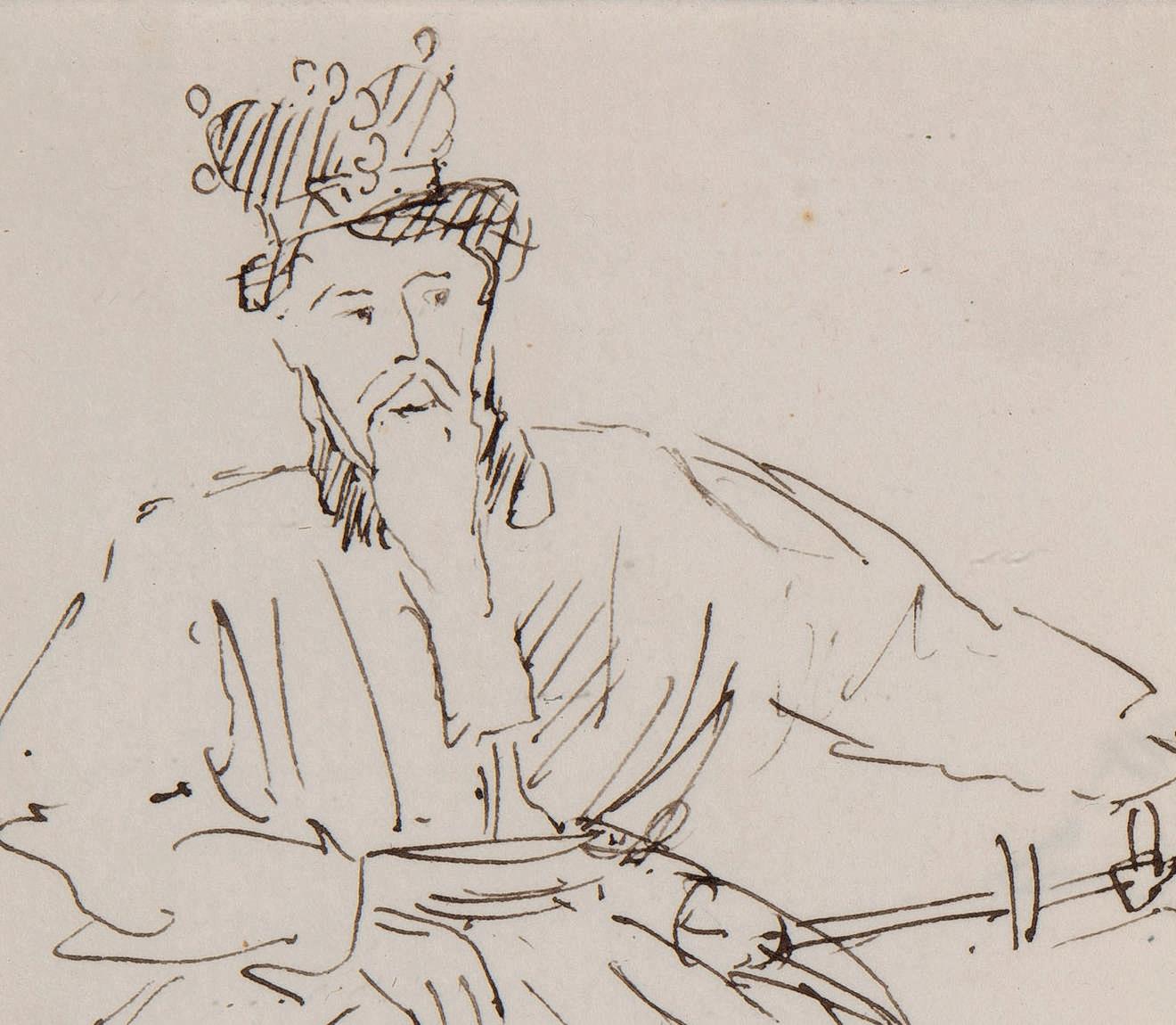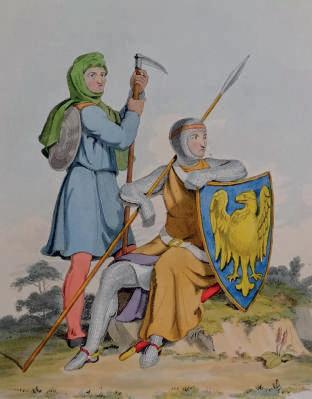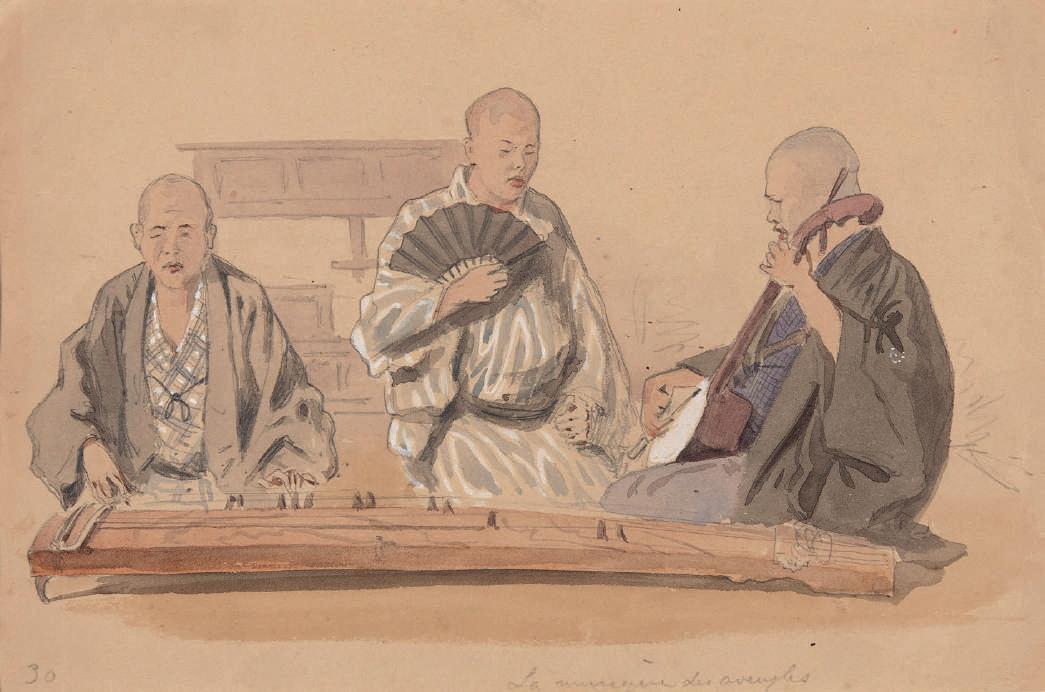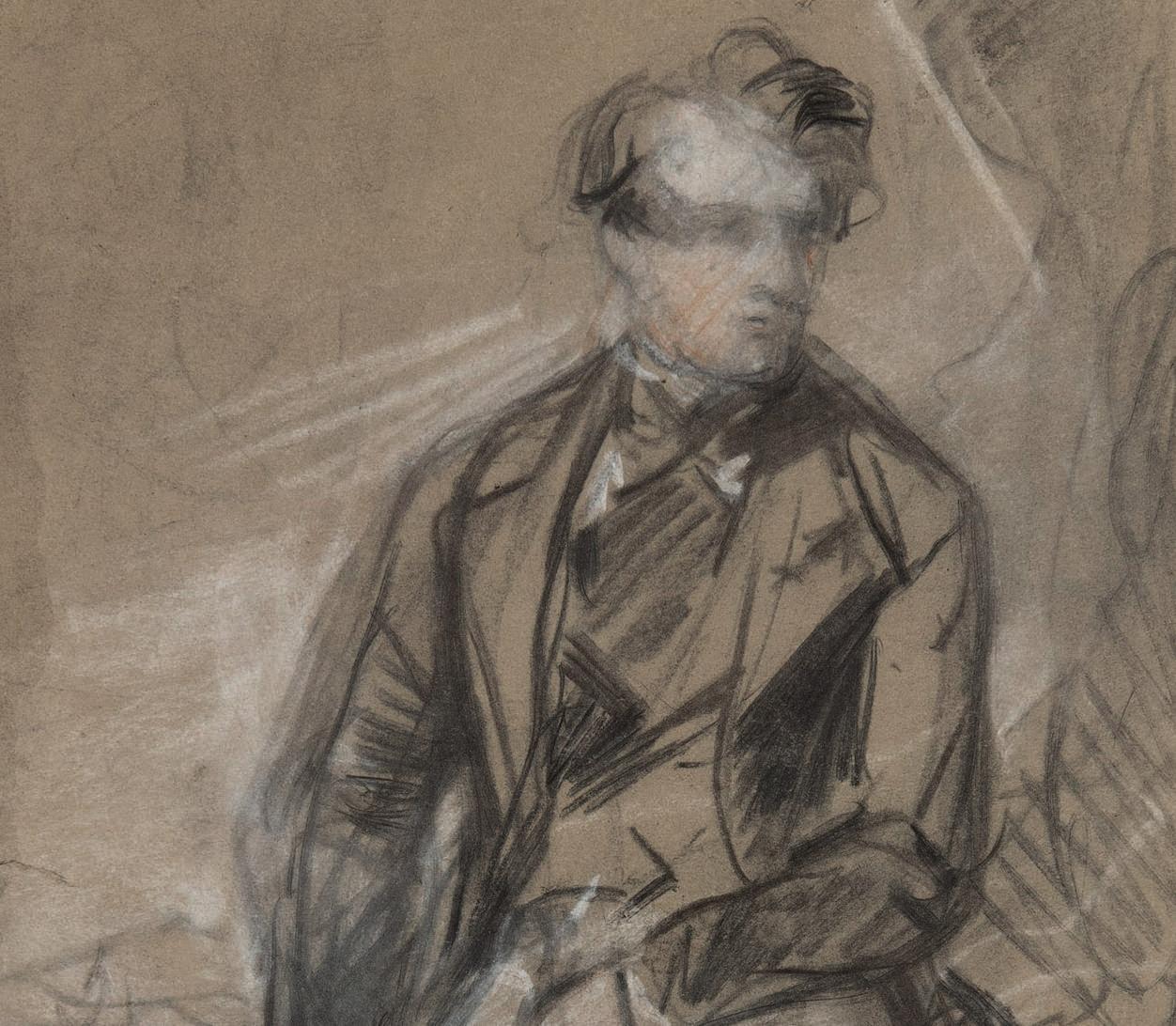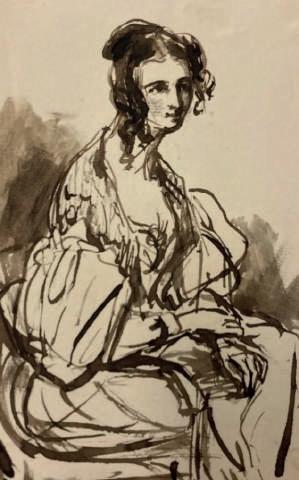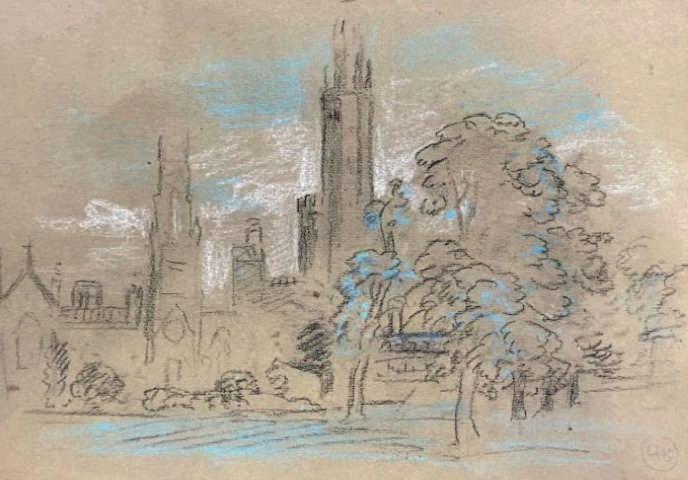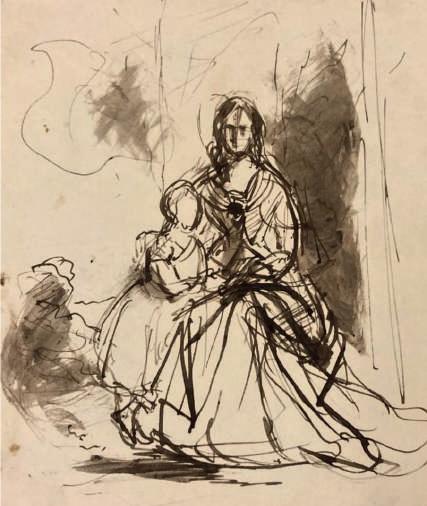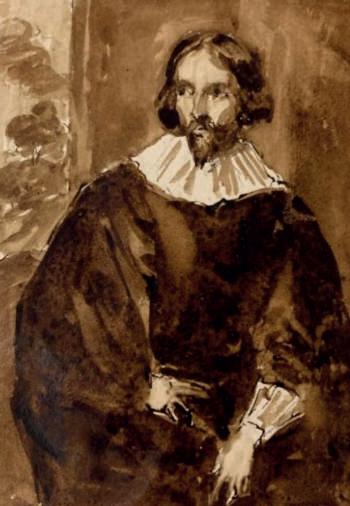SIR FRANCIS GRANT A
19th
Sir Francis Grant, P.R.A., Self-portrait, 1845, oil on canvas, 75.9 x 63.1 cm., National Portrait Gallery, London
Sir Francis Grant, P.R.A. (1803 – 1878) was a home-grown artistic talent; Queen Victoria herself once claimed that ‘he boasts of never having been to Italy or studied the old masters’. Her observations appear to have been accurate in so far as Grant was not the product of a vigorous artistic education at the Royal Academy, nor did he unduly concern himself with studying the antique or championing ambitious history painting. Parochial as they may have seemed, Grant’s artistic attitudes were by and large those of the major aristocratic and royal art patrons of mid-19th-century Britain. It therefore follows that by painting their portraits – it made no difference if his subjects were seated on a throne or a thoroughbred hunter – Grant’s ascent to the very top of his profession was assured.
Unlike many artists, Grant was no maverick outsider. The son of a Scottish laird, he was educated at Harrow and grew up at Kilgraston House, near Perth, an impressive seat hung with old master paintings and family portraits. Despite being a younger son, and therefore expected to find a profession, Grant still received a considerable inheritance of £10,000 on his father’s death in 1818. On reaching his majority, and with new liquidity, Grant set his sights south on the fabled hunting country around the town of Melton Mowbray in Leicestershire, a place that would become his lifelong home, shaping not only his career, but his social life too.
Sir Walter Scott, an early mentor to Grant, wrote that ‘he was passionately fond of fox hunting and other sports […] he used to avow his intention to spend his patrimony, about £10,000’. By 1827 Grant had been married and become a widower and, true to his word, he had spent his entire inheritance on buying paintings and keeping up appearances among the hunting fraternity at Melton Mowbray, its number described by ‘Nimrod’ as ‘the flower of English youth’ and, accordingly, as a conduit to the ‘best society in the world’.
Almost penniless, Grant returned to Scotland in 1827 and spent the next six years honing his skills as a professional painter. By 1833 he was back in England, living between Melton Mowbray and London. Crucially, he was by this time presiding over a growing professional practice, a practice that led Queen Victoria to comment snidely that although Grant ‘was a gentleman’, he ‘now paints for money’. In reality, Grant’s place in high society had been confirmed a few years earlier by his marriage in 1829 to Isabella Norman, a niece of Leicestershire’s premier nobleman, the 4th Duke of Rutland. Sir Walter Scott described the union: ‘the lady had not much wealth, but excellent connections in society, to which Grant’s good looks and good breeding made him very acceptable’.
As well as being a consummate sportsman, Grant was evidently a sociable and handsome man (a fact to which his 1845 self-portrait attests). He moved with ease between the hunting fields and aristocratic drawing rooms of the country and the artistic salons and academies in town. This dual existence is clearly reflected in the fact that Grant was not just a portrait painter, but an accomplished sporting artist too. Many of his earliest masterpieces were ambitious pictures of hunting subjects like his 1833 A Meet of the Buccleuch Hounds and 1835’s The Ascot Hunt, the latter painting containing dozens of mounted huntsmen and hounds artfully grouped in an extensive landscape.
His portraits are often broadly painted, yet sensitive, grand manner productions, very much descended from Van Dyck, Gainsborough and Reynolds. Of these, his portrait of his daughter, Mrs Markham (1857), now in the National Gallery of Scotland, is probably the greatest example. When he could, Grant would introduce sporting elements into his portrait commissions. Perhaps the most successful of these are two of his portraits of Queen Victoria: Queen Victoria Riding Out
(1840) and Queen Victoria on Horseback (1845), both of which are in the Royal Collection.
Grant’s career reached its apogee when, in 1866, he was both knighted by the Queen and elected President of the Royal Academy after his great friend, Sir Edwin Landseer, set aside his own ambitions for the position. By now known by his peers as ‘the fox-hunter’, Grant took a personal approach to the Presidency that was not one of rarefied theory or cool classicism; according to the painter Richard Redgrave, ‘what it [the Royal Academy] lost in calm impressiveness, it gained in geniality’. Grant’s great and lasting achievement as President was undoubtedly his skilful management of the Academy’s relocation from its cramped quarters at the National Gallery to the newly remodelled Burlington House, where it remains today.
Grant died in 1878 at Melton Mowbray. The Royal Academy’s offer of a burial at St. Paul’s Cathedral was refused in favour of a funeral at Melton Mowbray. The Academicians arrived by train from St. Pancras to a town whose shops had closed for the day out of respect for their esteemed neighbour.
The group of drawings exhibited here is the largest assembly of Grant’s work today. They have descended in his family and have never been publicly exhibited, much less offered for sale. The drawings, which represent his entire career both chronologically and thematically, are organised into four groups. The first and largest is entitled ‘High Society’ and is made up of sketches of Grant’s family and friends. Sensitive drawings of his beloved wife and daughters unsurprisingly appear with most frequency and the artist’s sympathy for these subjects radiates from each sheet. An extensive collection of sporting, animal and landscape drawings follows with highlights including a group of chalk studies of hounds
made in preparation for Grant’s painting The Kill, the Earl of Bradford, with the Belvoir Hounds. The third section demonstrates Grant’s working methods as a portraitist with numerous compositional sketches and detailed chalk studies. A small group of miscellaneous works concludes the exhibition. In addition to the works published here, there is a second, larger group of mounted, but unframed, drawings which will be exhibited alongside the framed pictures. Some highlights from this group are illustrated at the end of this catalogue.
A distinct picture of both Grant the man and the artist emerges through the study of these drawings. First, he was unarguably a dedicated family man, much devoted to his wife and children. Second, his exploits in the field were of paramount importance to him both socially and artistically. His easy manner and extensive connections are as plain to see in his drawings as they are in the many written records that confirm these facts. As a professional artist he was clearly meticulous in his preparation, as evidenced by the myriad portrait and sporting studies included in this show.
The final, and most important impression is that Grant was no hack. Grant’s artistic bent did not evaporate when he closed his studio door. Instead, he carried it out into the world by compulsively drawing those around him with perception, sympathy and good humour. Grant’s world is, at a distance of nearly two centuries, reflected back to us in this remarkable collection of drawings which, when taken together, constitutes a complete insight into the life of the artist and the high society in which he lived.
William Bayliss
All the following artworks are by Sir Francis Grant, P.R.A., unless otherwise stated.
All the following artworks are framed and mounted. Some artworks’ inscriptions are not included in the following illustrations.
I. High Society
1. Portrait of J.M.W. Turner*
pen and ink on paper 7 x 6 cm. (27 x 22 cm. framed)
This sketch, done on the back of a letter, depicts possibly the greatest British painter of the 19th Century, J.M.W. Turner, R.A. (1775 – 1851).
Grant enthused over Turner in his 1875 Royal Academy Discourse, declaring:
‘immortal Turner, whose early works, and most of his middle and best period, must be ranked among the noblest examples of landscape painting that the world has ever produced […] his later works […] were wonderful in their luminous qualities […] so luminous were they that they actually seemed to emit light.’
* On loan from a Private Collection; not for sale.
2. Edward Cecil Hope Grant, aged 19
inscribed Edward Cecil Hope Grant, aged 19
pen and ink on paper
12.5 x 11cm. (18 x 14.3 cm. framed)
3. Elizabeth Catherine Grant
inscribed E. C. G. March 1862
pen, ink and wash on blue paper
18 x 11.5 cm. (52 x 46.6 cm. framed)
The artist’s youngest daughter (1847 – 1933)
Mrs Grant inscribed Mrs Grant pen and ink on paper
18 x 11.3 cm. (55 x 45 cm. framed)
The artist’s second wife, Jane I.E. Norman (1829 – 1894). Jane was a niece of the 4th Duke of Rutland.
5. A
pencil and crayon on paper
23.3 x 18 cm. (52 x 43.6 cm. framed)
4.
lady in blue
6. A lady in profile, probably Mary Isabella Grant
pencil on blue paper
25.8 x 17.8 cm. (40.2 x 32.5 cm. framed)
Probably Mary Isabella Grant, the artist’s daughter; see no. 14.
ink, watercolour and bodycolour on paper
26 x 18 cm. (35.5 x 33 cm. framed)
pencil, watercolour and bodycolour on paper
17.8 x 25.5 cm. (37.5 x 52 cm. framed)
7. A seated lady
8. A lady reading
pen, ink and watercolour on paper
19.5 x 12.3 cm. (33.6 x 26.3 cm. framed)
pen, ink, wash and red chalk on paper
24.3 x 19.4 cm. (51 x 40.5 cm. framed)
9. A seated lady
10. A lady in a bonnet
11. Robert M. Norman, Esq. inscribed Robert M Norman Esq. pen, ink and wash on paper 28 x 21.2 cm. (53.5 x 48.5 cm. framed)
This is presumably Grant’s nephew on his wife’s side, Richard Manners Norman (1854 – 1895). Judging by the sitter’s dates, this must be a very late drawing by Grant. His mother was Adeliza Manners; see no. 13.
12. Miss Charlotte Norman
inscribed Miss Charlotte Norman. pen, ink, watercolour and pencil on paper
16.6 x 23.5 cm. (29 x 33.5 cm. framed)
This most likely depicts the artist’s sister-in-law, Charlotte Norman (1806 – 1869) (m. Atherton Powys, 1841), but it could be his wife’s first cousin of the same name (1795 –1855) (m. William Whitmore, 1830).
Mrs F. Norman
inscribed Mrs F. Norman. pen, ink, and wash on paper
15.9 x 23.2 cm. (32 x 39.5 cm. framed)
This depicts Adeliza Manners (1810 – 1877) who, in 1848, married her first cousin, Frederic Norman. Frederic was the artist’s brother-in-law. She is engaged in embroidery or another kind of handwork.
13.
14. Mary Isabella Grant (c. 1850)
inscribed verso, Mary Isabella Geary (Lady Geary) / daughter of / Sir Francis Grant, painted / by him. pencil and charcoal on paper 24.2 x 16.6 cm. (44.8 x 36.7 cm. framed)
Mary Isabella Grant (1831-1854) was the painter’s eldest daughter. He painted three pictures of her, one of which was exhibited at the Royal Academy in 1850. This drawing is closely related to the oil painting, Mary Isabella Grant Knitting a Shawl (c. 1850), in the Government Art Collection, and is very likely a preparatory sketch.
Mary married Sir Francis Geary, 4th Bt of Oxenheath in 1852, and died at the age of just twenty-two, less than two years later.
Same sitter as no. 30.
15. Mrs Grant & F. Grant
inscribed Mrs Grant & F. Grant pen and ink on paper, 11.3 x 22.1 cm. (45 x 59 cm. framed)
The painter’s wife with a child, either Francis (1834 – 1899) or Ferdinand Grant (1839 – 1875).
16. Daisy inscribed Daisy pen, ink, watercolour and pencil on paper
19 x 16.4 cm. (50.5 x 56 cm. framed)
This is a portrait of the artist’s daughter Anne Grant (later Mrs William Markham) (1835 –1880). She was known as Daisy by her family and is the subject of Grant’s famous portrait Mrs Markham in the National Gallery of Scotland.
17. Mrs Shaton
indistinctly inscribed Mrs Shaton (?)
pen, ink and watercolour on paper
14. 8 x 18.2 cm. (43.3 x 50.3 cm. framed)
The same sitter as no. 21.
18. Mama and Baby (1848)
inscribed Mama + Baby 1848
pen and ink on paper, 13.4 x 8.6 cm. (18.5 x 14 cm. framed)
This drawing, of a Raphael-type arrangement, most likely shows Mrs Grant with her youngest daughter, Elizabeth, who was born in 1847.
19. A lady pen and ink on paper
22 x 17.8 cm. (59.7 x 47 cm. framed)
21.
pen, ink and wash on paper
7 x 5.4 cm. (18.8 x 14 cm. framed)
indistinctly inscribed Mrs Shaton (?)
pen, ink and wash on paper
14. 3 x 11.2 cm. (40 x 30.2 cm. framed)
Same sitter as no. 17.
20. A lady
Mrs Shaton
22. Lord Stratford de Redcliffe
inscribed Lord Stratford de Redcliffe pen and ink on paper
14.6 x 16.1 cm. (49.5 x 49.5 cm. framed)
Stratford Canning, 1st Viscount Stratford de Redcliffe (1786 –1880) was the British Ambassador to the Ottoman Empire.
23. Lady Algernon St Maur
inscribed Lady Algernon St Maur pen, ink and wash on paper
23.7 x 19.5 cm. (55.6 x 48.5 cm framed)
The sitter is Harriet, the wife of Lord Algernon Percy Banks St. Maur, later 14th Duke of Somerset (1813 – 1894).
pen, ink and wash on paper
18.6 x 11.5 cm. (52.5 x 39.7 cm. framed)
inscribed Mrs Grant. pen, ink and wash on paper
21.7 x 15.4 cm (49.7 x 41.8 cm. framed)
The artist’s wife.
24. A lady in a bonnet
25. Mrs Grant
A lady
pen, ink and wash on paper
21.7 x 17.6 cm. (50.7 x 42.8 cm. framed)
27. Mrs D. Murray, 1850
inscribed F Gr 1850 /Honble Mrs D. Murray. pen, ink, and wash on paper
18 x 11.4 cm. (56 x 50 cm. framed)
Sir Francis Grant’s niece, Margaret (1821 – 1878), who married David H. Murray in 1840 and became 17th Baroness Gray in her own right.
26.
28. The Hon. James Macdonald
inscribed Hon. J. Macdonald
pen and ink on paper
11 x 6.6 cm. (45.5 x 38.2 cm. framed)
The Hon. James William Bosville Macdonald (1810 – 1882) was a Lieutenant-General and Aide-de-Camp, Equerry and Private Secretary to Prince George, Duke of Cambridge. Same sitter as no. 29.
29. The Hon. James Macdonald
inscribed Honourable James Macdonald
pen, ink and wash on paper
12 x 11.5 cm. (43.5 x 39 cm. framed)
Same sitter as no. 28.
Miss Mary Grant
inscribed Mif. M. I. Grant pen and ink on paper
15.8 x 11.2 cm. (44 x 50 cm. framed)
Mary Isabella Grant (1831 – 1854) was Sir Francis Grant’s eldest daughter. She became Lady Geary after her marriage to Sir Francis Geary in 1852. She died aged 22.
Same sitter as no. 14.
31. A seated lady
inscribed copy from F.G. pen, ink and wash on paper
14.4 x 11.5 cm. (41.5 x 36.3 cm. framed)
30.
32. The Rev. Colles, Rector of Melton Mowbray
pen, ink and wash on paper
18.1 x 11.3 cm. (56 x 50.5 cm. framed)
The Reverend William Morris Colles, shown preaching from his pulpit, was the Rector of Melton Mowbray church from 1866 until his death in 1889.
33. Rear Admiral Lord Adolphus FitzClarence
indistinctly inscribed --- --- Adolphus Fitzclarence. pen and ink on paper
10.3 x 11.2 cm. (32 x 42 cm. framed)
FitzClarence (1802 – 1856) was the illegitimate son of William IV and Dorothea Jordan. He was a naval officer who, when his father became king, was given command of the Royal Yacht, a position he held when Victoria came to the throne in 1837.
Mrs Grant knitting
inscribed Mrs F Grant. pen and ink on paper
22 x 18.2 cm. (50 x 56 cm. framed)
The artist’s wife.
34.
35. Mrs Grant
inscribed Mrs F. Grant. pen and ink on paper
22.6 x 18.5 cm. (50 x 56 cm. framed)
The artist’s wife.
36. Mrs Grant
inscribed Mrs F Grant. pen and ink on paper
15.5 x 13.4 cm. (38 x 32.7 cm. framed)
The artist’s wife.
pen and ink on paper
16.5 x 11.4 cm. (47.8 x 37.5 cm. framed)
37. A lady stitching
38. A seated lady reading pen and ink on paper
18 x 11.5 cm. (31.6 x 25 cm. framed)
39. Sketch of a man (recto); Sketch of a man and a woman in a ball gown (verso)
indistictly inscribed recto and verso so I suppose there will be another war next winter […] F Grant pen, ink and wash on paper 17.5 x 10.9 cm. (66.5 x 58.5 cm. framed)
(verso)
40. Sketch for a portrait of Sir Watkin and Lady Williams Wynn, together with A lady at a piano
inscribed Sep 5th 1856
pen, ink and wash on paper
24.2 x 11.3 cm. (63 x 45.3 cm. framed)
Grant’s finished portrait of Sir Watkin and Lady Williams Wynn is recorded by an 1862 print held in the British Museum.
41. A seated lady drinking tea
inscribed Sir F. Grant pen, ink, and watercolour on paper 15.2 x 9.8 cm. (61 x 46 cm. framed)
inscribed Christmas Singers, Becca Hall Sir F Grant pen, ink and wash on paper
18.5 x 22.5 cm. (32.5 x 39 cm. framed)
Becca Hall was the home of Sir Francis Grant’s daughter, Anne, on her marriage to William Markham.
42. Christmas Singers, Becca Hall
43. F.M. (?), Charades at Cufforth Hall
each inscribed Charades at Cufforth Hall / F.M. pen, ink and watercolour on paper each 17.2 x 25.1 cm. (28 x 36 cm. framed) (6)
F.M. are presumably the initials of a member of the Markham Family. Cufforth Hall and Becca Hall appear to be the same place and the names were presumably used interchangably.
44. A child in a highchair
inscribed Sir F Grant pen, ink and wash on paper
16.8 x 18.9 cm. (75 x 67.5 cm. framed)
45. Mama
inscribed Mama / Sir F Grant. pen and ink on paper
8.7 x 7 cm. (17.5 x 15 cm. framed)
inscribed “Daisy’ Sir F Grant. pen, ink and wash on paper
17.6 x 11.2 cm. (47.5 x 39 cm. framed)
The artist’s daughter.
pen, ink and wash on paper
16.5 x 14.8 cm. (70 x 59 cm. framed)
46. Daisy
47. A lady
48. Carlo Pellegrini (‘Ape’), Sir Francis Grant (sketch for Men of the Day, no. 21, Vanity Fair, 19 April 1871)
signed C Pellegrini / Ape, stamped UNFINISHED PREPARATORY SKETCH pencil and white chalk on paper
43.2 x 34 cm. (58 x 49 cm. framed)
Carlo Pellegrini (1839 – 1889) was the caricaturist for Vanity Fair from 1869 – 1879.
pen and ink on paper
8.9 x 8 cm. (14 x 11 cm. framed)
The same sitter as no. 50.
pen and ink on paper
13.4 x 11 cm. (30.5 x 25 cm. framed)
The same sitter as no. 49.
49. A lady in a hat
50. A lady in a hat
51. A woman knitting pen and ink on blue paper
26.3 x 21 cm.
(58.5 x 58 cm. framed)
10.8
6 x 11.2 cm. (11 x 14 cm. framed)
52. A lady
pen and ink on paper
x 7.5 cm. (14 x 11 cm. framed)
53. A clergyman and another figure
pen and ink on paper
pencil on paper
7.5 x 5.5 cm. (14 x 11 cm. framed)
inscribed Sir F Grant pen, ink, and wash on paper
11.2 x 8.5 cm. (14 x 11 cm. framed)
54. A young child
55. A girl
pen and ink on blue paper
57. A man
7.6 x 7 cm. (14 x 11 cm. framed)
56. A child sleeping
inscribed Sir F. Grant. pen and ink on blue paper; an oval
5.3 x 9 cm. (11 x 14 cm. framed)
II. Sporting, Landscape and Military Subjects
58. (Possibly) Sir Edwin Landseer, R.A., A stag hunting party above Taymouth Castle
with slip of paper inscribed Original sketch for Drawing by Landseer. Some Caricatures & a Drawing by Mrs Norton pen and ink on paper
11.2 x 18 cm. (26 x 34 cm. framed)
A group of figures and stag hounds process through the landscape above the Tay Valley, with Loch Tay ahead and the unmistakable shape of Taymouth Castle to the right. The castle’s distinctive towers were the product of a rebuilding campaign that concluded in 1842. Queen Victoria and Prince Albert visited the castle later that year as Lord Breadalbane’s guests. It is possible that this drawing commemorates this event.
59. Two anglers inscribed april 28/1859 pen, ink and crayon on paper each 11 x 18 cm. (58.5 x 45 cm. framed together)
60. A gentleman hunting
pen and ink on paper 18.2 x 11 cm. (34 x 29.5 cm. framed)
This sketch bears a striking resemblance to an 1858 engraving by James Brownley Hunt after Grant of James Morrell, the ‘late Master of the Old Berkshire Foxhounds’, now held in the British Museum.
61. A trooper of the 9th or 17th Lancers
pen and ink on paper
22.5 x 16 cm. (49 x 41.5 cm. framed)
Possibly a copy after an old master painting.
62. Horses and a fallen rider
pen and ink on paper
19 x 23 cm. (38 .5 x 46.5 cm framed)
pen and ink on paper
18.5 x 22.8 cm. (39 x 48.5 cm. framed)
Possibly a study for a painting entered by Grant at the Royal Academy in 1829 called A Battle Piece Painted from Imagination.
63. A cavalry skirmish
65. Death of a soldier
pen and ink on paper
19 x 22.4 cm. (41 x 50 cm framed)
pen and ink on paper
22.1 x 18.3 cm. (61.5 x 51 cm. framed)
Perhaps after an old master painting.
64. A horse and rider
Fig. 1: Sir Francis Grant, P.R.A., Portrait of Charles Trelawny, Esq., Master of the Dartmoor Hunt, oil on canvas, 180.3 x 124.5 cm., sold Sotheby’s, New York, 9 June 1995, lot 121
66. Study for the portrait of Mr Trelawney, Esq., Master of the Dartmoor Hunt
inscribed Mr Trelawney / Sir F Grant pencil and watercolour on paper
17.5 x 13.5 cm. (61.5 x 51 cm. framed)
The finished version of this picture was sold at Sotheby’s in 1995 (fig.1). The composition is very similar to the present watercolour although there is an additional hound to the right.
67. Two hunting views pen, ink and wash on paper each 7 x 12 cm. (36 x 40 cm. framed together)
18.5 x 22.4 cm. (35 x 45 cm. framed)
Same sitter as no. 69.
68. A huntsman
pen, ink and crayon on paper
69. A huntsman
inscribed G. Kendall (Postboy) / Sir F Grant. pen and ink on paper, 22.4 x 18.4 cm (39.5 x 32.5 cm. framed). Same sitter as no. 68.
70. A lady and gentleman out riding
inscribed Sir F Grant
pen, ink and wash on paper
11.8 x 12 cm. (35.5 x 33 cm. framed)
71. A hunter with hounds
pen, ink, and wash on paper
12.8 x 11.2 cm. (71.5 x 61.5 cm. framed)
72. Sailing
indistinctly inscribed as seen through the glass / Sir F Grant [---].
pen, ink, and wash on paper
17.9 x 11.4 cm. (37 x 30 cm. framed)
73. John Grant, A cavalry skirmish
inscribed John Grant. pen, ink, and wash on paper
11.4 x 17.9 cm. (61 x 76 cm. framed)
Presumably by Sir Francis Grant’s brother, John (1798 – 1873).
inscribed FGt 1826.
pen, ink, and wash on paper
19 x 22.8 cm. (32.8 x 41.3 cm. framed)
74. Riders with dogs hunting a fox, 1826
75. Sir Francis Grant, P.R.A., after Sir John James Stewart, Bt., Cavalry at an encampment
inscribed FGt after Sir J Stewart Bart. pen, ink and wash on paper
18 x 22.5 cm. (39.5 x 57.6 cm. framed)
Stewart (1779 – 1849) was a landowner and amateur artist.
76. The Kinross road
pencil and watercolour on paper
18.3 x 22.8 cm. (55 x 76 cm. framed)
77. A boy in a landscape with a bridge (recto); A boy (verso)
crayon on paper
26.3 x 18 cm. (37.5 x 48 cm. framed)
(verso)
78. Study of three hounds’ heads, for ‘The Kill, the Earl of Bradford, with the Belvoir Hounds’ (recto); Study for Order of the Thistle, for ‘Portrait of James Duff, 5th Earl of Fife’ (verso)
chalk and pastel on paper
52.5 x 36.8 cm (71.6 x 58.5 cm. framed)
A study for hounds in the picture at Weston Park depicting the Earl of Bradford mounted next to the Belvoir Hounds Huntsman, Frank Gilliard, who holds a dead fox aloft with the Duke of Rutland riding into view behind. (verso)
79. Study of a hound for ‘The Kill, the Earl of Bradford, with the Belvoir Hounds’ (recto); Study for a hand holding a top hat and cane (verso)
chalk and pastel on paper
52.4 x 36.2 cm. (83.2 x 67.5 cm. framed)
A study for a hound in Grant’s picture at Weston Park (verso)
80. Study of a hound for ‘The Kill, the Earl of Bradford, with the Belvoir Hounds’
chalk and pastel on paper
52.5 x 36.7 cm. (79 x 64 cm. framed)
A study for a hound in Grant’s picture at Weston Park
81. Study of two hounds for ‘The Kill, the Earl of Bradford, with the Belvoir Hounds’ (recto); Study for a portrait of a gentleman (verso)
chalk and pastel on paper
36.7 x 52.2 cm. (47.8 x 63 cm. framed)
A study for two hounds in Grant’s picture at Weston Park.
(verso)
82. Study of a hound
chalk and pastel on paper
52.3 x 36.7cm. (66 x 55 cm. framed)
83. Study of a stag and hinds in a landscape
crayon and pastel on paper
18.2 x 24 cm. (36 x 40.3 cm. framed)
This drawing and the five deer studies that follow are most likely the product of the final years of Grant’s career when he turned his attention back to his native Scotland and executed a series of landscapes populated with deer.
84. Study of a stag chalk and pastel on paper
26.2 x 18.2 cm. (44.5 x 37 cm. framed)
chalk and pastel on paper
24 x 18.2 cm. (41.4 x 31.5 cm. framed)
chalk and pastel on paper
18.4 x 26 cm. (40 x 46 cm. framed)
85. Study of deer’s legs
86. Study of a deer
88.
chalk and pastel on paper
24.2 x 18.6 cm. (40.5 x 32 cm. framed)
18.4 x 26.7 cm. (35 x 41 cm. framed)
87. Studies of a hind, recto and verso
chalk and pastel on paper
Study of a hind
89. Falling horseman pen, ink and wash on paper
18.6 x 16.4 cm. (62.5 x 54.7 cm. framed)
90. A sporting gentleman seen from behind
pen and ink on paper
23 x 19 cm. (43 x 33 cm. framed)
91. A horse and rider with a hound
inscribed Sir F Grant pen and ink on paper
8 x 6 cm. (14 x 11 cm. framed)
92. (Possibly) William Gill, Kilgraston
inscribed W. Gill / Kilgraston Perth
pencil and watercolour on paper
17.4 x 25.2 cm (49.5 x 68 cm. framed)
The Grant family seat and childhood home of Sir Francis Grant.
III. Portraits and Portrait Studies
oil on canvas
25.4 x 20.3 cm. (46 x 41 cm. framed)
In 1829 Grant married his second wife
Jane Norman, a niece of the 5th Duke of Rutland. The sitter in this portrait is her father, Richard Norman, Esq., who married Lady Elizabeth Isabella Manners, the sister of the 5th Duke of Rutland, in 1798. As his son-in-law, Grant was the obvious choice of artist when it came to Norman’s portrait commission.
93. Portrait of Richard Norman, Esq.
Fig. 2: Sir William Charles Ross, R.A., Sir Francis Grant, watercolour on ivory, 8.9 x 7.1 cm, Private Collection.
94. Francis Grant
inscribed Francis Grant . del. After Sir W Ross pen, ink and wash on blue paper
22.5 x 18.5 cm. (57.5 x 47 cm. framed)
A copy by Grant of his miniature portrait by Sir William Charles Ross, R.A. (1794 – 1860) (fig. 2).
95. Study for a group portrait
bodycolour on paper
12.3 x 9.5 cm. (17.8 x 15.8 cm. framed)
96. Study for a portrait of a gentleman
pen and ink on paper
22.5 x 18.6 cm. (41.1 x 36.4. framed)
97. Study for a portrait of Lady Arthur Lennox
inscribed Lady. a. Lennox.
pen and ink on paper
18.2 x 15 cm (56.5 x 46.5 cm. framed)
A study for a portrait of Lady Arthur Lennox (1803 – 1888) by Grant. The finished portrait was etched by W. Joseph Edwards, with an impression held in the British Museum
98. Study for a portrait of a lady
pen and ink on paper
5.5 x 4.5 cm. (14 x 11 cm. framed)
99. Study for a portrait of a gentleman indistinctly inscribed C Broadley & m R. pencil, chalk and pastel on paper
29.1 x 22.4 cm. (54 x 45.5 cm. framed)
100. Study for a portrait of Mr Woodale
inscribed Sketch for picture painted of Mr Woodale –Scarborough pencil, chalk and pastel on paper 26.7 x 20.6 cm. (46 x 40.7 cm. framed)
Fig. 3: Sir Francis Grant, P.R.A., Portrait of a Lady and a Gentleman, small full lengths in an interior, oil on canvas, 66.6 x 43.3 cm., Private Collection.
101. Study for a portrait of a lady and a gentleman chalk and pastel on paper
22.7 x 18.5 cm. (48.7 x 42.2 cm. framed)
An oil sketch of this composition sold at Christie’s in 1980 (fig. 3).
(verso)
102. Study for H.R.H. the Duke of Cambridge at the Battle of Alma leading the Guards up the hill in support of the Light Division, 1868 (recto); A terrier (verso)
chalk and pastel on paper
55 x 33.3 cm. (72.3 x 87 cm. framed)
Fig. 4: Sir Francis Grant, P.R.A., H.R.H. the Duke of Cambridge at the Battle of Alma leading the Guards up the hill in support of the Light Division, 1868, oil on canvas, 213.2 x 185.4 cm., Royal Military Academy, Sandhurst
of George III), commanded the 1st Division, comprised of footguards and highlanders, and led them up the heights in support of the 2nd Division and the Light Division who had gone before.
Grant’s nephew, Francis (1829 – 1854) fought at Alma and, the day after the battle, wrote to his parents:
‘Crimea, near the River Alma Sep. 21 1854
This energetic chalk drawing is a study for the monumental depiction of the Battle of Alma at the Royal Military Academy, Sandhurst (fig. 4). The Battle of Alma, fought on 20th September 1854, was the first major engagement of the Crimean War. The allied British and French armies advanced up the slopes above the Alma River and drove out the Russian troops that were defending the heights. The Duke of Cambridge, a cousin of Queen Victoria (and a grandson
My beloved Mother, We fought a general engagement yesterday and crossed the river in the face of the enemy, then carried his position at the point of the Bayonet. We, the 79th have escaped almost miraculously – we mounted a steep hill in the face of a redoubt which was pouring round shot, musketry and shells upon us – they almost all struck short of us and ricoche’d over our heads. We had only 2 men killed and 8 wounded. Not so the rest of our force however – the Fusilier Guards lost about 200 men and 11 officers (killed and wounded, I mean) – the 23rd 8 officers killed – Harry Anstruther among them, the 19th have lost nearly half their men. The Highland Brigade about 140 killed and wounded – Young Abercromby – 93rd – killed. I should say 2000 of the enemy are lying dead around us, the whole country is strewn with them. Balgonie and Hay Drummond are well. I hope and think this horrible war will be over in a few days – God knows I have seen enough of it – Love to my Father and all – Mary, Annie and Lucy.’
Francis survived the battle, only to die of cholera twelve days later at Balaclava on 1st October 1854.
103. Study for a portrait of a gentleman chalk and pastel on paper
52.4 x 37 cm. (64 x 51 cm. framed)
104. Study for a portrait of a gentleman chalk and pastel on paper
52.5 x 37 cm. (56 x 46.2 cm. framed)
(verso)
105. Study of the legs of an officer (recto); Study of two boys (verso)
chalk and pastel on paper
52.4 x 36.8 cm. (87.5 x 69.5 cm. framed)
106. Study for a portrait of a gentleman chalk and pastel on paper 56 x 41 cm. (92.3 x 79.5 cm. framed)
107. The Duke of Richmond’s legs
chalk and pastel on paper
32.4 x 36.7 cm. (71.5 x 62 cm. framed)
A study for the portrait of Charles Lennox, 6th Duke of Richmond. This portrait was published as a mezzotint in 1877 by Richard Josey. An example is held in the British Museum.
108. Study for the portrait of Sir William Miles, Bart., MP pencil, chalk and pastel on paper 36 x 24 cm. (52.4 x 44.5 cm. framed)
A study for Grant’s portrait of Sir William Miles. Miles (1797 – 1878) was a Tory MP from 1818-65 and was a prominent agriculturist and landowner. The completed portrait was printed in 1862 as a mezzotint, an example of which is in the British Museum.
IV. Copies after Old Masters and other Miscellaneous Works
Fig. 5: English School, Peter Earl of Richmond and a Soldier, c. 1820s
109. Peter Earl of Richmond
inscribed – Peter Earl of Richmond - / A.D. 1248 – Drawn by F Grant & pasted in by Emily Grant pen, ink and watercolour on paper
23.5 x 18.8 cm. (36.5 x 27 cm. framed)
After an early 19th-century print (Fig. 5).
110. An old beggar, 1826
inscribed FGt 1826 / Pity the sorrows of a poor old man / whose trembling limbs have borne him / to your door pen, ink and wash on paper
11.7 x 12 cm. (73 x 64 cm. framed)
111. The Penitent St Peter
inscribed Spagnoletto pixt / F Grant fect / Luke – chap XXII - / verse 61 – and 62 - / and Peter remembered the word of the Lord, how he had/ said unto him, Before the cock crow, thou shalt de - / - ny me thrice / and Peter went out, and wept bitterly – FGt March 1827
etching
10.2 x 8.8 cm (66.5 x 58 cm. framed)
After a painting by Jusepe de Ribera formerly in the Grant collection at Kilgraston.
112. A grenadier and an officer
indistinctly inscribed and dated July 11th / 68
pen and ink on paper
18 x 11.2 cm (32.5 x 27 cm. framed)
113. Pay Day
inscribed tradesmen receiving their money / Pay day
pen, ink and wash on paper
16.6 x 11.2 cm. (40 x 27 cm. framed)
A housekeeper settling grocer’s and fishmonger’s bills against the butler’s book.
7 x 6 cm. (14 x 11 cm. framed)
11.1 x 7.2 cm. (14 x 11 cm. framed)
114. Sketch of a portrait bust
pen and ink on paper
115. A king
pen and ink on paper
116. Charles Wirgman, La musique des aveugles (The music of the blind)
inscribed La musique des aveugles and verso, Three Blind musicians
watercolour and pencil on paper
15.5 x 24.5 cm. (37 x 47.3 cm. framed)
Wirgman (1832 – 1891) was a British painter, caricaturist and cartoonist who worked in Yokohama and founded the Japan Punch magazine.
inscribed C Wirgman / Jeune Fille
watercolour and pencil on paper
22.5 x 15.5 cm. (47.2 x 36.6 cm. framed)
inscribed La c------ C Wirgman, watercolour and pencil on paper
15.5 x 22.5 cm. (33.3 x 38.5 cm. framed)
117. Charles Wirgman, Jeune Fille
118. Charles Wirgman, A lady in an interior
Dickinson is showing a further group of over 130 unframed drawings by Sir Francis Grant, P.R.A., as part of the exhibition.
These drawings, all of which are mounted, will be offered for sale with prices starting from £50.
Please scan this QR Code for the online catalogue.
The following drawings are some highlights from the unframed group.
I. High Society
,
A lady
pen, ink and watercolour on paper, 23 x 18.5 cm.
A mother and child, pen and ink on paper, 23 x 18.4 cm.
A lady, pen, ink and wash on paper, 18.2 x 11.2 cm.
II. Sporting, Landscape and Military Subjects
A rearing horse, pen, ink, and wash on paper, 11.3 x 10.2 cm., indistinctly inscribed Sir F Grant.
View of a large house, possibly Fonthill Abbey (recto); Study of a stag in heather (verso), crayon and pastel on paper, 18.3 x 26.2 cm.
III. Portraits and Portrait Studies
Mrs Talbot Clifton, pen, ink and wash on paper, 16 x 9.7 cm., inscribed Mrs Talbot Clifton / Sir F Grant. Study for a portrait of a gentleman (recto); and Landscape (verso), pencil on paper, 25.5 x 17.8 cm.
Study for a portrait of Mrs Edward Strutt and her Son, pen and ink on paper, 21.4 x 17.5 cm., inscribed Mrs Strutt & Child.
IV. Copies after Old Masters and other Miscellaneous Works
Copy after an old master, pen, ink and wash on paper, 9.8 x 7.2 cm.
Study of two boys, chalk on paper, 52.4 x 36.6 cm.
after Studio of Paolo Veronese, Venus and Adonis, etching, 15.6 x 12.7 cm., inscribed F Grant del / Robertson & Ballantine’s lithog / Paul Veronese.









